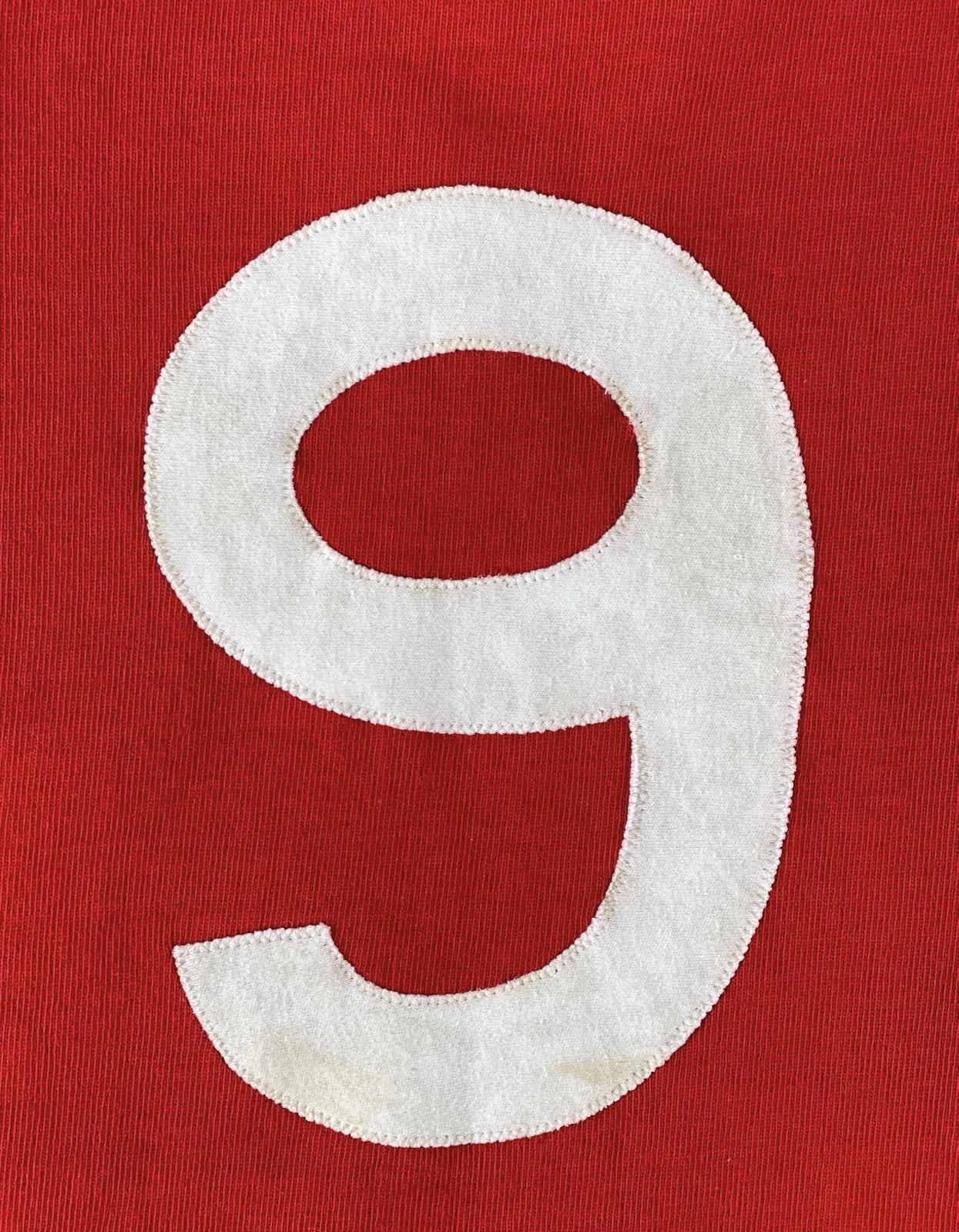




The Auction: Friday February 24th 2023 at 2pm at our Cardiff Auction House
In the room (by appointment only)
Real time online (via our website)
Commission bids (via our website) Telephone bidding (by arrangement)
Buyer’s Premium on all lots at 20% (inclusive)
Please see full details and terms at www.rogersjones.co.uk
If you would like to view lots in person, please contact us to schedule an appointment
Cardiff Auction House | 17 Llandough Trading Estate, Penarth, Cardiff, CF11 8RR Tel: +44(0)29 2070 8125 | ben.rogersjones@rogersjones.co.uk
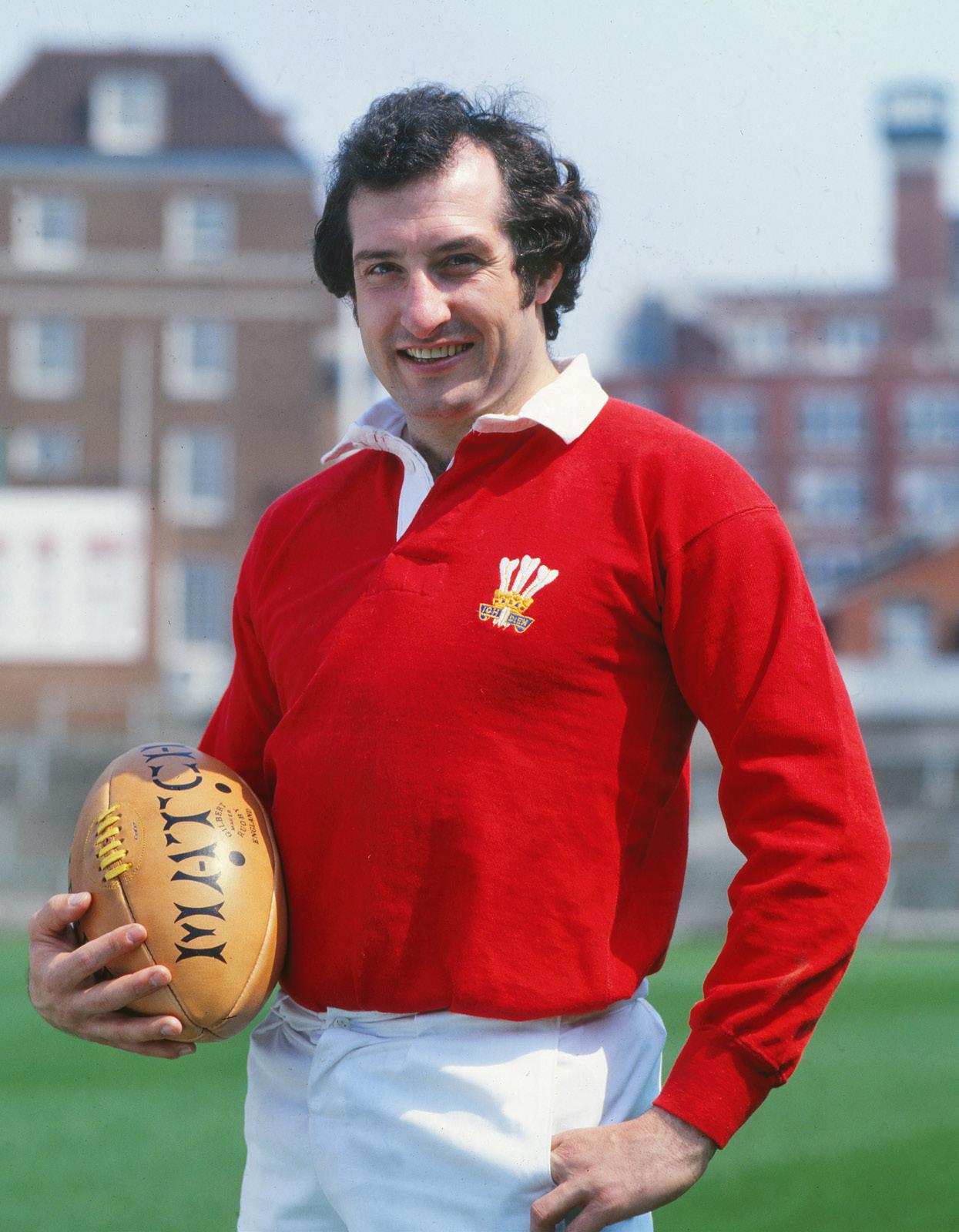
Historic rugby jerseys have been making waves at auction for several years now. The auction record as it stands was created at our own auction rooms, back in 2015, when legendary All Black Dave Gallaher’s jersey sold for £180,000. But what is it that is driving this demand for historic and iconic jerseys?
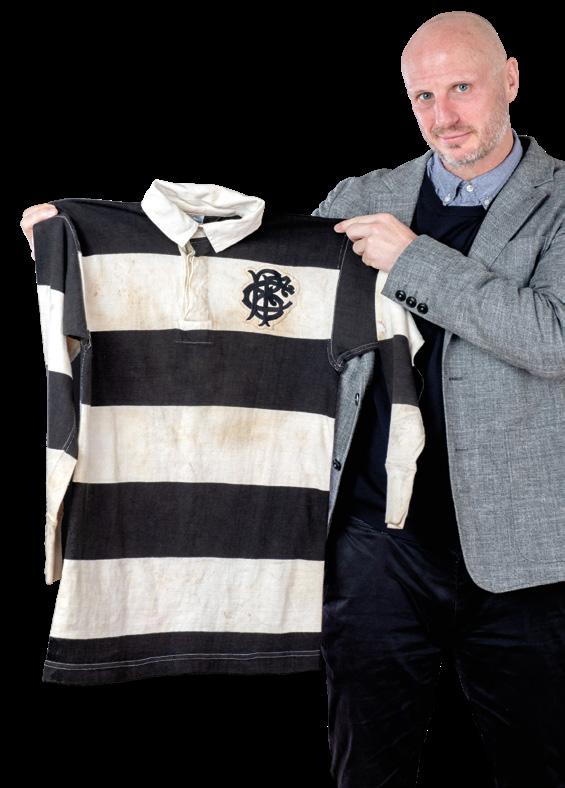
Museums are full of everyday artefacts which don’t have intrinsic or aesthetic value. We spend our time admiring them and even more time still, absorbing the stories behind them. We are fascinated by what such artefacts represent, those moments in history, the human emotions involved and how objects left their mark individually or to many people. Some objects having played a part in changing the course of history.
Military medals and militaria have changed hands for many years in the auction rooms of the world, often for thousands of pounds and sometimes for hundreds of thousands of pounds. In this way sporting items are no different. Behind every historic rugby jersey there is a story and there are the same human emotions. I am not of course comparing the sacrifices made on a battlefield to those on a sports-field, but there is the same group of emotions in both. There is triumph, courage, dedication, great skill and of course sadness, poignancy, and despair. And these emotions are not limited to the sportsperson who might have graced the field. Iconic artefacts such as Sir Gareth’s Barbarians jersey of 1973 have meaning to so many of us.
Our spines tingle still when we hear Cliff Morgan’s legendary commentary and all of us have those pangs of nostalgia. All of us, even New Zealanders, will delight in such a brilliant, improvised rugby.
I am sure you will recall where it was that you saw ‘that try’ for the first time. For me, it was as a teenager on a worn-out video called ‘101 Best Tries’. For some of you, it will have been on the BBC, on that day on January 27th 1973. And for a lucky few, it would have been from the stands in Cardiff Arms Park. Wherever you were, the try will not leave you, it is a moment that you will never forget. Sport is powerful, it stirs the emotions, and we should never underestimate it.
It is a great honour to be offering this incredible sporting collection to auction, it is one of my greatest career highlights. It has been an honour to handle, research and document such important historic artefacts.
Behind the folds of every jersey there are great rugby players, some are still with us, others no longer, but not one of them are forgotten. Behind the folds of each jersey there is great entertainment, there are notorious matches and controversial tours.
And there is a sport, still amateur, played for no other reason than for the love of the game, and played with incredible skill and athleticism by the very best.
There are also complicated political landscapes, and there is social and of course sporting history.
...and then there is the story of Sir Gareth Edwards, regarded as the greatest ever rugby player...
Ben Rogers JonesSir Gareth Edwards is widely regarded as the greatest player to have ever graced a rugby field. During a golden era for Wales he was the star player. He scored two of the most famous tries of all time, and was an all-round genius with the ball in his hands. Sir Gareth, the son of a miner was born on July 12th, 1947 in Gwaun-cae-Gurwen, Neath Port Talbot, South Wales. He was brought up as a Welsh speaker.
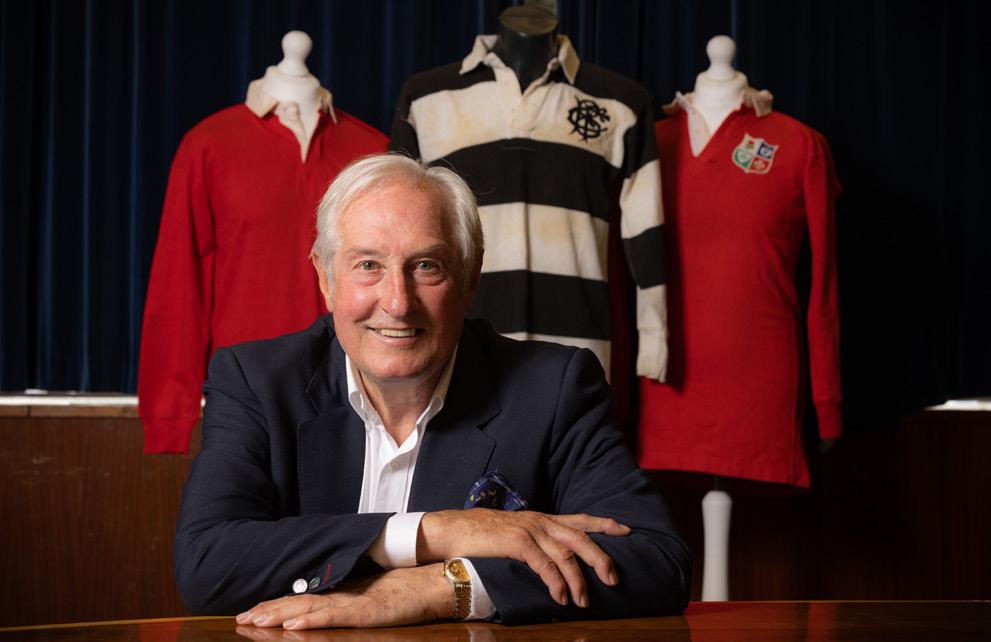
From an early age it became apparent that Gareth had immense potential in sports. The man to unlock that potential was his teacher, Bill Samuel.
Edwards was a talented soccer player and was offered a contract to play for Swansea Town, but his preference was rugby. So, Bill Samuel was determined to make him focus on the sport and he helped the young Gareth gain an athletic scholarship for Millfield Public School in Somerset, a school renown for sports.
At Millfield, Gareth impressed at other sports, including gymnastics, athletics (he was the Welsh national long jump and British schools sprint hurdles champion) and soccer. But before long his supreme rugby skills were noticed by some of the top rugby clubs, and he joined Cardiff RFC, opting to go back to Wales.
Edwards soon became the star of the Cardiff side, and in 1967, at the age of only 19, he received his first international call-up. After a few more Welsh caps, it became apparent that Gareth Edwards wasn’t just capable at the highest level, he thrived on it. He quickly became the first name on the team sheet and a firm favourite with the fans.
His talent, calmness on the field, his reading of the game and leadership, resulted in his being named team captain for Wales, just one year on since his first cap. At only 20-years old Gareth Edwards became the youngest player to ever captain Wales - a record which still stands.
He was then named in the 1968 British Lions squad to tour South Africa when he was still only 21. Edwards started the first two tests of that tour and would have played in all four had he not been injured.
He remained one of the best players in the world throughout 1969 and 1970.
It was in 1970 that Edwards suffered an injury against England. He had to leave the pitch with 20 minutes remaining. This is significant because it is the only time in Gareth Edward’s 11 year international career that he failed to complete a match. There was never a drop in form, and he was never again injured.
In 1971 he played a huge part in Wales’ Five Nations Grand Slam, their first since 1952. It was the beginning of the golden era for Welsh rugby with some of the greatest players including Barry John, Phil Bennett, Gerald Davies, Mervyn Davies and another Millfield ‘old boy’ JPR Williams, to name but a few.
In 1971 he was also selected for the British Lions tour of New Zealand. The tour was a huge success, and Edwards was at the centre of it all. He played in all four tests as the Lions won the series 2-1 (one was drawn). The Lions won 22 matches on the tour, drew one, and lost one. It is a record in New Zealand the likes of which had never been seen.
And it remains and always will remain ‘that try’.
CAPS: Wales 53 (35 wins, 5 draws), Lions 10 (5 wins, 3 draws)
CAPTAIN: Wales (13)
POINTS: Wales (88), Lions Tests (3), Lions all (58)
TRIES: Wales (20)
The following year more glory followed as Edwards scored one of the best tries ever, against Scotland. He ran most of the length of the pitch, displaying phenomenal speed and stamina to score. Then in January 1973, Gareth Edwards’ try against Scotland was surpassed in its brilliance by a score for the Barbarians, which is still regarded as the greatest ever. And it remains and always will remain ‘that try’.
More success followed in 1974 as he was again named in the Lions squad for South Africa. This squad ended up rivalling the 1971 squad for the greatest Lions tour of all time. Edwards was the ever-present scrum-half in both squads.
In South Africa the Lions won every single game but one, drawing against the Springboks in the final test, after already having won the series 3-0.
In 1976, he played another critical role in a Wales Five Nations Grand Slam, furthering the unprecedented success the Welsh side were experiencing at the time.
The following year he declined the opportunity to make a return to New Zealand with the Lions, and the year after in 1978, he played his final match for Wales.
Sir Gareth Edwards played 53 times for his country. From his debut for Wales in 1967 to his final match in 1978, he played in every single Welsh game. Dropping Gareth Edwards from the team during this period was never a consideration.
He scored 20 tries for Wales, a record then for an international scrum-half. He made ten appearances for the British Lions.
Since his retirement, numerous players, including those he played with and against, have said he is the greatest of all time and in 2003, in a poll of international rugby players he was declared to be just that. The greatest rugby player to play the game.
In 2007, former England captain Will Carling published the ‘50 Greatest Rugby players’ in The Daily Telegraph, he also ranked Edwards the greatest ever, stating, “He was a supreme athlete with supreme skills, the complete package. He played in the 1970s, but, if he played now, he would still be the best. He was outstanding at running, passing, kicking, and reading the game. He sits astride the whole of rugby as the ultimate athlete on the pitch”
TRIPLE CROWNS: 5 (1969, 1971, 1976, 1977, 1978)
GRAND SLAMS: 3 (1971, 1976, 1978)
OUTRIGHT FIVE NATIONS TITLES: 5 (1969, 1971, 1975, 1976, 1978)
ALL GAMES FOR WALES: 65
ALL GAMES FOR LIONS: 39 (3 tours)
GAMES FOR BARBARIANS: 11 (8 v International teams)
GAMES FOR CARDIFF: 195 (67 tries)
MBE 1975
CBE 2007 for services to sport
Knighted 2015 for services to sport and for charitable services
Welsh Sports Personality of the Year 1974 Youngest captain of Wales
First player to win 50 caps for Wales
Most consecutive Tests (53) in world rugby for one country
Wales & Scrum-half position record try scorer at the time (20)
World Rugby ‘Hall of Fame’ 2007 inductee
Welsh Sports Hall of Fame ‘Roll of Honour’ 1998 inductee
Cardiff RFC Hall of Fame
Honorary Degree Swansea University


Jersey in original and complete condition without fault.
Provenance: the personal collection of Sir Gareth Edwards CBE & family.
the match set such a high standard of excellence that it will forever be a yardstick by which games of rugby football union will be judged.
The Barbarians versus New Zealand match was played at Cardiff Arms Park to a capacity crowd on 27th January 1973. It remains one of the most famous rugby union matches of all time, in which certainly the most famous try of all time was scored. ‘That try’…commonly described as ‘the greatest try’ was scored by Sir Gareth Edwards - wearing this jersey.
The match was the final contest for New Zealand’s 1972/73 tour of the British Isles. It was regarded by the All Blacks as a chance to revenge their test series loss against the British Lions in 1971 - all but three of the Barbarians having been on the ‘71 tour. It was also an opportunity for the British public to see their victorious British Lions in action with some of the most exciting players in a golden era for rugby taking part, including JPR Williams, David Duckham, John Dawes, Phil Bennett, and Willie John McBride. The All Blacks with
Sid Going opposite Sir Gareth Edwards at scrumhalf and captained by one of the best flankers, Ian Kirkpatrick. The match was spectacular, with some of the best passers, runners, and side-steppers playing in their prime. It was a high energy game full of adventure, running breaks, improvisation, and spontaneity. Especially from the Barbarians, who, coached by Carwyn James, had an appetite to play rugby ‘in the spirit of the Barbarians’.
Nigel Starmer-Smith said, “the match set such a high standard of excellence that it will forever be a yardstick by which games of rugby football union will be judged’. Sean Fitzpatrick said the match ‘inspired me to take up rugby’.
The Barbarians won 23–11 with tries from Edwards, Slattery, Bevan and JPR Williams. Grant Batty scored two for the All Blacks.
In the second minute, New Zealand winger Bryan Williams kicked the ball over Phil Bennett deep into the Barbarian’s half. Bennett retrieved it under his own posts, then with virtually the entire field between him and the All Black’s try line, he sidestepped and evaded three tackles. He then passed to JPR, who managed to offload, despite a high tackle.
Still deep in their own half, the ball passed through four pairs of Barbarians hands (Pullin, Dawes, Tommy David, and Quinnell) while heading up-field on the left, before Gareth Edwards shot between two teammates to take the pass from Quinnell.
Edwards dived in the left-hand corner for the try at the Taff End, to a rapturous reception. It was 22 exhilarating seconds after Bennett had gathered under his own posts.
It would be a try forever etched in rugby folklore and that epitomized all that was good about rugby and teamwork in sport. The Barbarians were not regular team-mates so the try was not one of coaching and drills, instead it was of talented athletes expressing themselves while enjoying the time of their lives.
Still to the day, 50 years later the try is known as ‘that try’ and considered the greatest ever scored. Unquestionably the try is the most iconic in rugby union history.
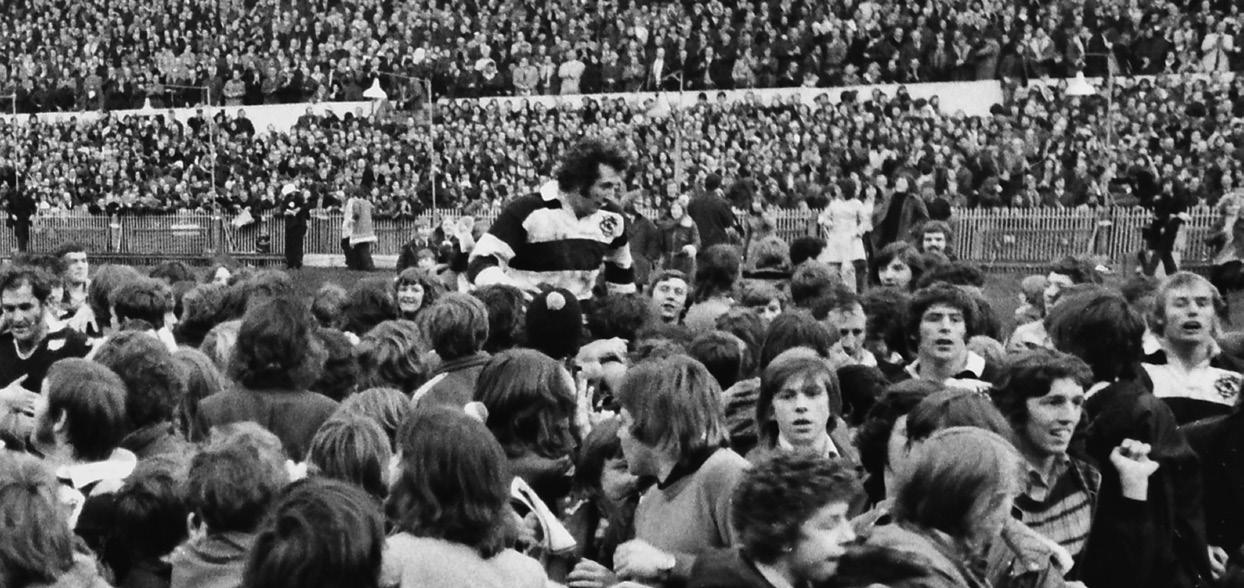
The iconic status of ‘that try’ was bolstered by Cliff Morgan’s spine-tingling commentary, said to be the second most repeated UK television sporting commentary after Wolstenholme’s ‘They think it’s all over…’. ‘Kirkpatrick to Williams.
A moment later ‘Oh that fellow Edwards’ and ‘If the greatest writer of the written word would have written that story, no one would have believed it. That really was something’
Arguably it was ‘that try’, ‘the greatest try’ which served as Gareth Edwards coronation as the greatest ever player.
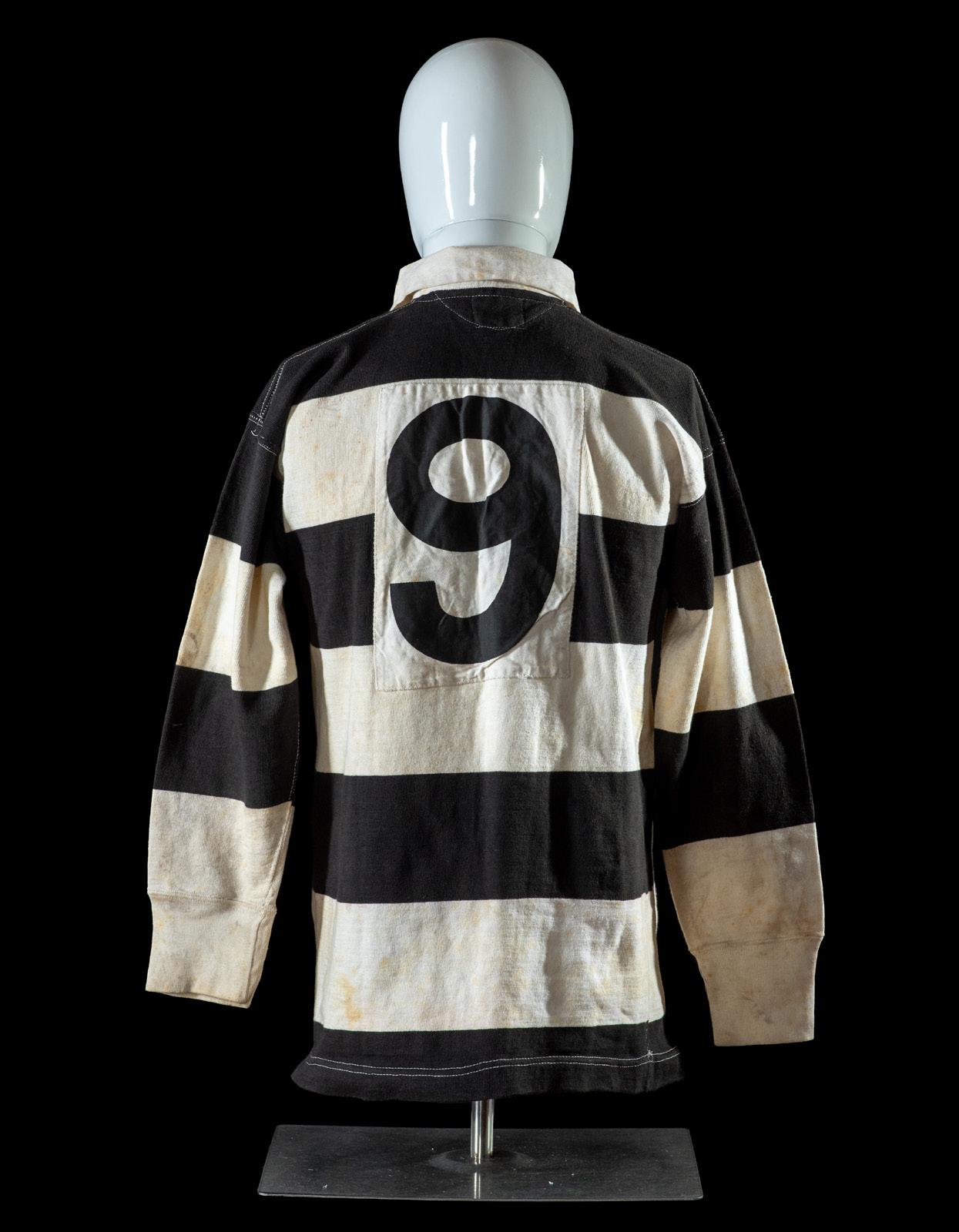
‘that try’, ‘the greatest try’

“The game against the All Blacks is one I will never forget and those of us who played in it will never be allowed to forget.”
It is a match that will live with me forever. People tend only to remember the first four minutes of the game because of the try, but what they forgot is the great deal of good rugby played afterwards, much of which came from the All Blacks.

I remember that I was cursing just minutes earlier because Sid Going (New Zealand scrumhalf), hoofed the ball downfield, JPR Williams hoofed it back, Bryan Williams (New Zealand wing) hoofed it downfield once again, I was running in all directions. You are out of breath in the first 10 minutes of any game because your heartrate isn’t settling down, there is a bit of tension and you are a bit nervous, especially in this match.
When that ball went back to Phil, I thought ‘he will kick it to touch, we will have a lineout, I will have a bit of a breather’ but just when I was thinking all those glorious things, I looked up and thought ‘where the hell is he going now?
I was trying to get out of the way, initially. The movement was all coming towards me, I could see John Dawes, I could see JPR, so I thought I would get out of the way and let the move continue, but then as a scrumhalf I thought I had better get there. I did then get there. When I saw the gap, I shouted to Derek Quinnell ‘Twl e ‘ma’ (throw it here).
I still remember the thrill, the surge of adrenalin as I took the pass and hit the gain line before sweeping around Karam.
I am often asked what was going through my head when I took the pass from Derek. Well, the only thing in my mind was whether my hamstrings would stand up to the all-out sprinting.
‘I prayed they wouldn’t seize up in that mad dash for the corner’.
Wherever I go in the world, people want to talk about it. In the 1990s, I was fishing in the middle of nowhere in Russia – it was a three-hour helicopter ride from Murmansk. I was staying in a village where the mayor, who was a former nuclear submarine commander, took me back to his house, brought out a DVD, shoved it on the telly and up came that try!
What I loved about it more than anything was the improvisation and the decisions off the ball. There were loads of fabulous play from both teams, some stupendous improvised rugby of playing with the ball in front of you.
Eight years ago, we sold captain Dave Gallaher’s All Black jersey from their 1905 tour for £180,000. Since then, I have been asked whether I think another jersey will come close or exceed that world record. Sir Gareth Edwards’ Barbarians jersey was my answer from the start.
Gallaher’s jersey was surely the most significant example from the early years of rugby. But Gallaher was not known of widely beyond New Zealand or rugby historians. Despite this, it realised £180,000 because it was historically important.
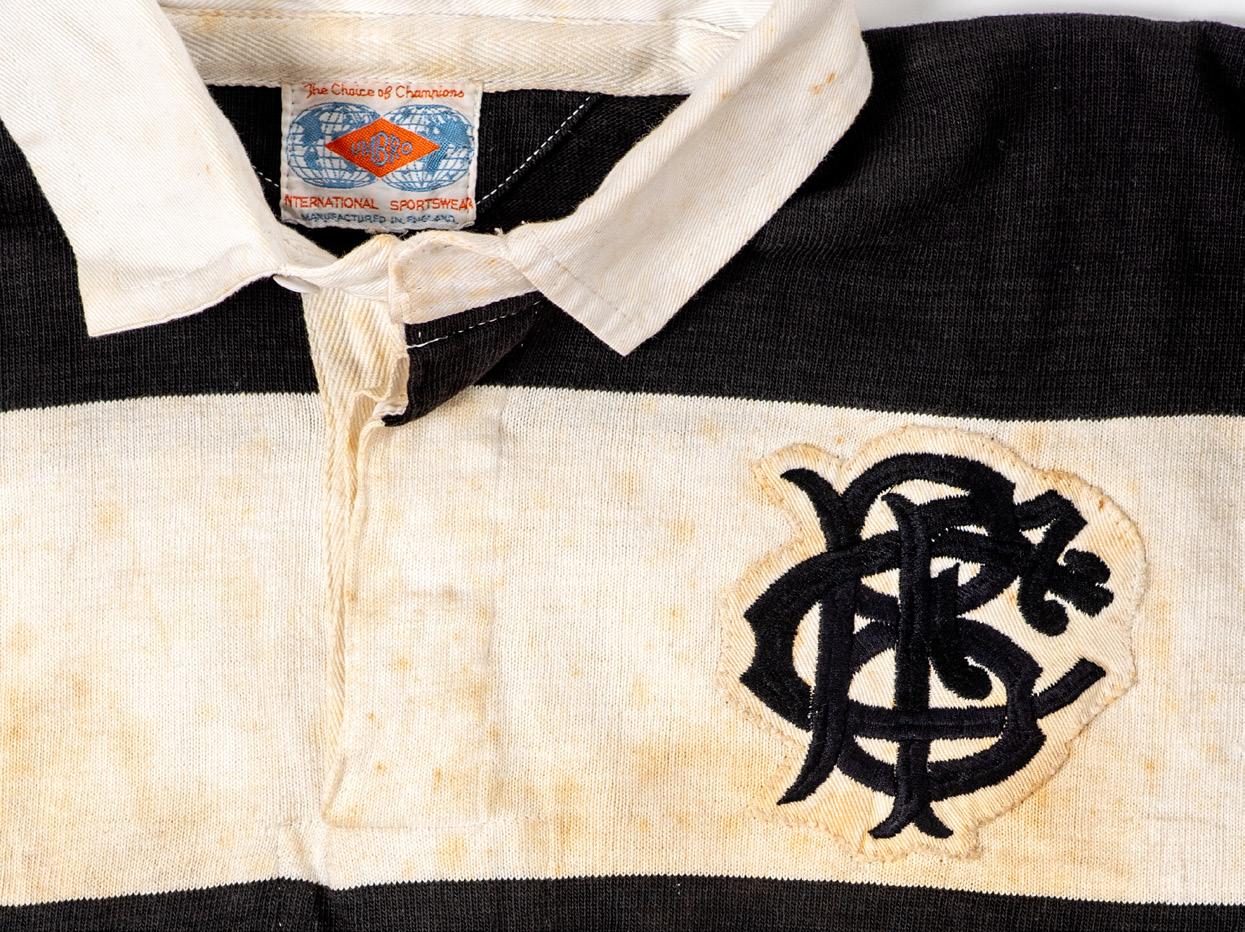
Sir Gareth’s Barbarians jersey is historic too but more than that it is iconic. It is known the world over.
It was a try that was dreamed of in schoolyards, terraced gardens and bedrooms. A try which inspired a generation of children to play the sport.
As a Welshman it is good to remind people that the famous match and that try is thoroughly Welsh in its character; the match was played in Cardiff, the accompanying iconic commentary from the Welsh voice of Cliff Morgan,
the move was started sensationally by Phil Bennett’s sidesteps and then the ball went through a succession of Welsh hands, before being finished emphatically by Sir Gareth. Further, it should be noted that the try was linguistically Welsh too, with Gareth Edwards yelling ‘Twl e’ ma’ to his fellow Cymro, Derek Quinnell.
For the people of Wales this greatest try reverberates deeply.
This is the jersey worn by Sir Gareth Edwards – considered the greatest ever, playing in the most famous rugby match. It was – and still is, ‘that try’, the greatest try. It follows, that this is the ‘greatest jersey’. A sporting icon.
Estimate: £150,000-200,000


Jersey in original and complete condition without fault. Manufacturer’s label for Umbro (two globes type), crest features English rose in red as opposed to purple, No.9 to reverse, printed Umbro ‘Choice of Champions’ to hem.
Provenance: the personal collection of Sir Gareth Edwards CBE & family.
In 1974, the British Lions controversially accepted the invitation to tour South Africa in defiance of the developing international policy to isolate South Africa during the apartheid regime.
The Lions were captained by Irish forward Willie John McBride and were coached by former Irish forward Syd Millar. Two forwards to lead the party was deemed the best strategy to combat the renowned physical presence of the Springboks, the Lions were to fight fire with fire. This strategy prepared the Lions for, probably, the most violent tour that they had played, even bearing in mind the battlegrounds that they had left three years earlier in Canterbury and Hawkes Bay, New Zealand.
The Lions preparation was focussed on forward play and in particular the scrummaging which had been identified as being a Springbok weakness. The Lions had plenty of experience and toughness in the pack with Bobby Windsor at hooker, Fran Cotton, Mike Burton, McBride, Roger Uttley, Fergus Slattery, and Mervyn Davies.

But they also had plenty of flair in the back division; JPR, JJ Williams, Phil Bennett, Mike Gibson, and Sir Gareth Edwards wearing this jersey.
After winning the first two Tests 12-3 then 28-9 in Cape Town and Pretoria respectively, the Lions took on the Springboks on July 13 in what was later dubbed ‘The Battle of Boet Erasmus Stadium’.
Once again, the game is best remembered for its physicality but there was some great rugby played. Having ridden out the storm of the Boks’ initial assault, Gordon Brown bundled over from a lineout and the Lions went in 7-3 ahead at the break. After the interval the Lions turned the screw and JJ Williams bagged two tries as the Port Elizabeth crowd were treated to a Lions masterclass.
The Lions had shown in no uncertain terms they could not be bullied and two tries from wing JJ Williams, plus a score from Gordon Brown, wrapped up a 26-9 victory and, with it, the series.


The 1971 tour in New Zealand is usually regarded as the finest ever, but in truth the 1974 Lions tour to South Africa surpassed the feats three years earlier. The Springboks were as much respected as the All Blacks, and the Lions in South Africa had also to contend with high altitudes, which gave the Springboks a distinct advantage.
The tour may be infamous for physicality, for punch-ups and the legendary 99-calls which were invented by the Lions when a ‘one in all in’ confrontation was needed.
But the tour should be remembered as a tour of Lions tries, scoring even more tries than the ‘running Lions’ of 1955. It was a record-breaking tour for the British Lions in which they amassed a record breaking 79 points in four tests and scored an incredible 729 points across the tour. The Lions became the first team to beat the Springboks in a four-match series, J J Williams racked-up a new try record for a tour with 6 tries, and the Lions hammered South Western Districts 97-0, the biggest win ever for a touring side in South Africa. The Lions went through the tour undefeated, winning 21 of their 22 matches with only a draw in the final Test preventing a clean sweep.
It was a humiliation for South African rugby. The Springbok captain Hannes Marais admitted that the Lions were the best team he had ever played against, including the All Blacks of 1970.
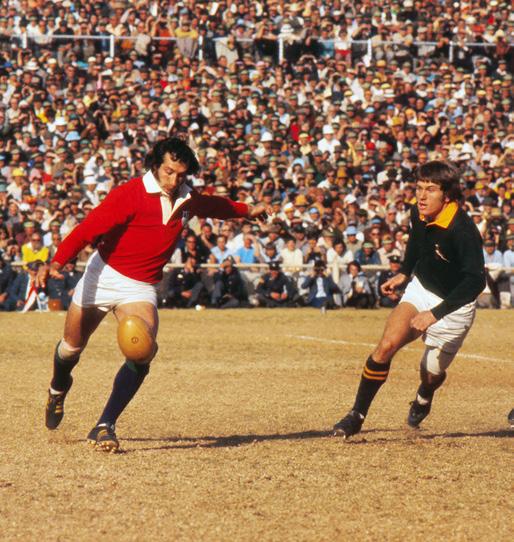
Sir Gareth Edwards was a key figure in both the New Zealand and South African successes but in South Africa it was his on-field decision making and execution that was applauded. According to Clem Thomas, His kicking had South Africa on the rack throughout the tour. As did his long pass, which did much to protect the free-running of Phil Bennett. Gareth’s running from the base was also a constant threat and produced many crucial tries, and this tour provided some of the finest hours of his illustrious career.
With regards to the controversy surrounding the 1974 Lions tour, Sir Gareth Edwards talks candidly in his autobiography,
‘…we made a point of seeking out black people and asking them for views. The majority said they thought we were right to tour, a few felt we should have stayed away. But what most said was, ‘You give us the will to go on’.
That will had increased significantly by the time we had finished our tour unbeaten, Rugby was the game of the Afrikaner which is why black people took so much pleasure from our win. It was as if we had delivered a blow on their behalf.
Nelson Mandela subsequently made it clear that the tour worked against the Afrikaner in the long run. The Afrikaner believed he was secure in his ascendancy, but we proved by thrashing his beloved Springboks that it wasn’t the case at all’.
Estimate: £20,000-25,000


Red jersey with white collar in original and complete condition. Bears label for Umbro (two globes), applied badge to chest with embroidered leek for Wales and silver fern for New Zealand, cotton No.9 to reverse.
Provenance: the personal collection of Sir Gareth Edwards CBE & family.
In 1967 the New Zealand All Blacks toured Great Britain, France, and Canada. The series consisted of 17 matches with four Tests against the Home Nations.
The New Zealand team finished the tour undefeated, the first time they had achieved this in the Northern hemisphere since the 1924–25 ‘Invincibles’ team.
The nearest the All Blacks of 1967 came to defeat was a drawn match against a hastily assembled East Wales at Cardiff Arms Park, captained by Sir Gareth Edwards.
The match had originally been scheduled for Saturday, December 9th, but due to a heavy snowfall the terraces were deemed too dangerous for supporters and so the match was rescheduled for the following Wednesday afternoon.
Despite the kick-off rescheduled to the middle of the week just before Christmas, 40,000 rugby fans filled the stadium, most expecting an easy win for the unbeaten, physically impressive All Blacks.
But East Wales had a strong side out, including established Internationals such as the Cardiff backs Keri Jones, Gerald Davies, Barry John, and 20-year-old Gareth Edwards who had been made captain for the match. There was mobility in the pack too with Jeff Young, John Hickey and Tony Gray featuring. And from the start, the East Wales pack made the New Zealand forwards look ponderous, consequently the All Blacks half-backs were under pressure throughout.
In the 22nd minute, East Wales won a line-out and Barry John tried a dropkick which swerved away to the left of the posts, but Frank Wilson, the East Wales, winger was alert enough to follow-up, gather and touchdown to make the score 3-0. Shortly afterwards the home side could, and maybe should, have been awarded a penalty try, when a diagonal kick intended for winger Keri Jones, saw him race to the line with McCormick, only for the New Zealander to barge him

out-of-the-way off the ball. The poor luck continued for East Wales as later in the first half Wilson went over for another try, only to be called back for an infringement.
It remained 3-0 to East Wales at the end of the half but in the second-half East Wales had their tails up and launched waves of attack on the stunned All Blacks. However, several kickable penalties were missed by the Welsh and the tension began to build.
Then 10 minutes from time, completely against the run of play, All Black Lochore raced away from the scrum on halfway with Bill Davis in support, Davis passed it out to Steel who had 50 yards to go. A try did not look likely, but Steel beat off tacklers to score a fabulous solo try to level the match.
It was a huge blow to the East Wales side who had been in command for most of the game. To their credit, they fought back and there was almost a sensational finish when Barry John’s drop goal in the closing moments of the game, grazed the right upright.
Tony Steel’s try avoided embarrassment for the All Blacks, and it proved to be the most important try of the 1967 tour as New Zealand’s unbeaten record was saved. But it was a match that East Wales should have won.
‘I remember the match vividly for a number of reasons. For a start I was made captain, which was a feeling of pride and apprehension. I was barely 20, though it was only a few months later that I captained Wales for the first time. Dai Hayward, the former Cardiff and Wales wing, was asked to coach the East Wales side, though coaching was very much in its infancy then. He said we’d better meet up and have a chat about the game, so we met in what was then the Cockney Pride, a pub in Cardiff, where over a lunch of curry and chips and a bit of half and half, we discussed our tactical approach to this enormous event. I can still remember Dai’s opening line: “Well boy, there’s no point complicating anything.” If we get hold of the ball, he said, let’s move it.
We were supposed to be playing them on the Saturday. I was in college at the time and my roommate Nick Williams who’s still my friend and business colleague went to the window in the morning and said: “I tell you, you won’t be playing the All Blacks today.” The whole town was covered in snow. I went down to the Angel Hotel, where we were due to have lunch, to find out what was going on. It turned out the All Blacks
were staying there as well, so we had a few beers together. We played on the Wednesday instead, but we still got about 40,000 there.
It might be a case of the old memory playing tricks, but I think we completely outplayed them and should have won it. For a long time we led 3-0 and it didn’t look for a moment like they were going to score. At one stage the All Blacks were trying to summon a bit of energy, and one of them shouted out loud: “Come on boys, we’ve got them on the run here.” And John Hickey, in no uncertain terms, said: “You have got to be joking!”
He used a few expletives as well. The look on his face was an absolute picture.
Afterwards the All Blacks’ manager, Charlie Saxton, spoke to us, and said they were very, very fortunate not to have lost. It was a harsh lesson for a young player like me to learn, but the All Blacks absolutely never gave up until the game was over. Tony Steel went on a great run down the wing, and that was 3-3. It was just about the only chance they had. Even then, Barry John had a drop-goal chance at the death that just took the paint off the upright. Had we won it, against one of the greatest teams I ever played against, people would still be talking about it with great reverence. It was a wonderful performance by a side that had been put together literally in a week’.
A rare rugby union jersey from a famous match from the early days of Sir Gareth’s playing career.
A hastily assembled team stopped the New Zealand juggernaut in sweeping away all that faced them on the 1967 tour. Although perhaps a disappointing result for the East Wales players, having outplayed the formidable All Blacks for much of the match, it was one of the most famous draws and was a massive coup for the regional side.
* the preceding is an extract from Sir Gareth’s autobiography. Sadly, Nick Williams OBE, a life-long friend of Sir Gareth’s from Millfield School, died in 2022. Estimate: £1000 - 2000
Come on boys, we’ve got them on the run here.

Red and white squared jersey with white collar in complete and original condition. Bears large black Lillywhites label and blue Umbro print to hem, shield shaped chest badge with English Rose and Prince of Wales feathers with blue ribbon, black canvas No.9 to square white panel on reverse.
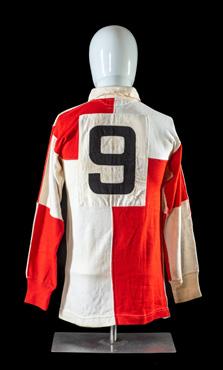
The Scotland-Ireland XV included Mike Gibson, Duncan Paterson, Frank Laidlaw, Peter Brown, Willie-John McBride and were captained by Tom Kiernan. England and Wales scored four of the seven (three-point) tries through Keith Fielding, Dai Morris, Barry Llewellyn, and John Spencer. But JPR Williams could only land one of his conversions, and so despite leading for most of the match, the Scotland-Ireland team were able draw 14-14 through a last minute try by Alan Duggan.

In 1970, the Rugby Football Union embarked on a season of celebrations to mark the 100 years since the formation of the Rugby Football Union. It was on 26th January 1871 when representatives from 21 football clubs held a meeting at the Pall Mall Restaurant, Regent Street and founded the original Rugby Football Union. Centenary events culminated in an historic specially arranged match between a combined England-Wales XV, against a similarly arranged Scotland-Ireland XV. The showpiece clash was held at Twickenham on October 3, 1970, to a full stadium. The game was a fitting tribute to the sport, with some of the most celebrated players of the era taking to the field. In the England-Wales XV, was Gareth Edwards, JPR Williams, Gerald Davies, David Duckham, Barry John, John Pullin, Mervyn Davies and was captained by Bob Taylor.
‘A very special occasion marking the centenary of the Rugby Union. I enjoyed such commemorative matches and getting the chance to get to know and play alongside some of those players I would normally play against’.
Provenance: the personal collection of Sir Gareth Edwards CBE & family.
All red zipped tracksuit by Umbro with single zipped diagonal pocket, bearing Umbro interior label with fabric diamond logo, ruby and white Umbro diamond with black outline applied to chest opposite traditional British Lions four section shield, ‘10’ stitched to side of waist (Gareth’s squad number). Zip handle missing.
Provenance: the personal collection of Sir Gareth Edwards CBE & family.
‘We didn’t have tracksuits from the Lions in 1968, so these were unique. Carwyn James made sure we were properly equipped for New Zealand and looked good. We as players were delighted, especially in the New Zealand climate’.
Estimate: £500-1000


Rugby Union squad jersey issued to Sir Gareth Edwards for Canada tour

Jersey in complete and original condition. Bears label for Umbro (two globes), embroidered Prince of Wales feathers above ‘Canada Tour 1973’, white canvas No.7 to reverse.
Provenance: the personal collection of Sir Gareth Edwards CBE & family.
The match played at Varsity Stadium Toronto on 9 June 1973. Wales won 58-20 with Sir Gareth Edwards captaining the side. Matches against Canada were uncapped for Welsh players during this period.
‘Traveling to places like Canada was a big excitement for anyone back in the early 1970s. Rugby opened my eyes to the world’.
The 1973 Canada jerseys were unique as the only time Wales players wore squad numbers for matches.
Estimate: £700-1000
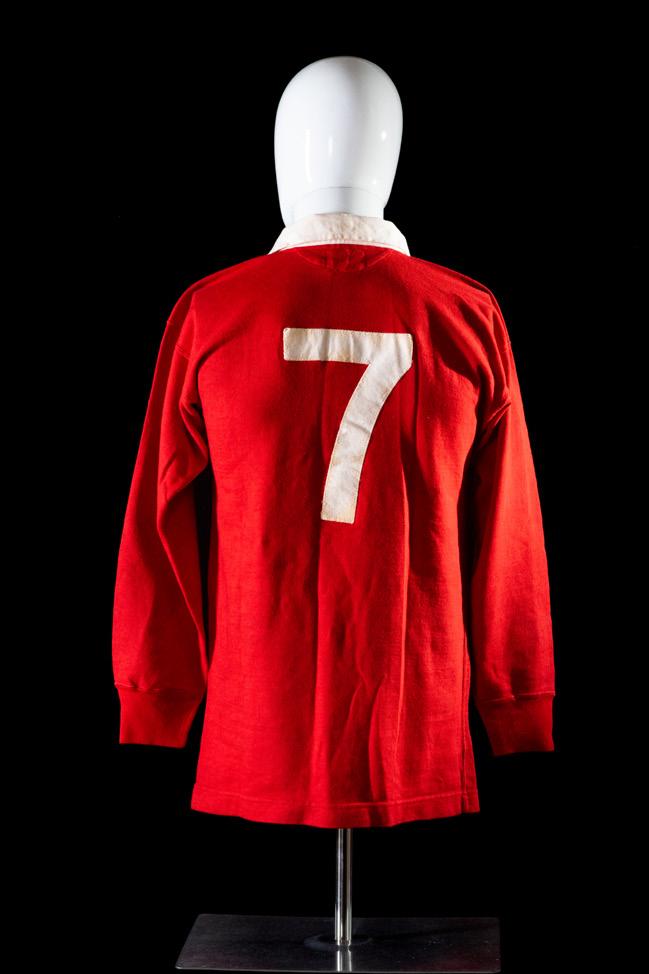

International Rugby Union jersey match-worn by Sir Gareth Edwards
Jersey in original match-worn and complete condition. Bears manufacturer label for Umbro in orange diamond within two globes above ‘International Sportswear’, complete with buttons, No.9 and Prince of Wales feathers.
Provenance: the personal collection of Sir Gareth Edwards CBE & family.
Gareth Owen Edwards won his first international cap for Wales against France, on April 1st, 1967. He was 19 years old. The match ended with defeat to that season’s Five Nations Champions. But only a year later, Edwards became Wales’ youngest ever captain in February 1968 at the age of 20 and winning his first game in charge against Scotland. It was the beginning of the golden era for Wales.
It had been an exciting sporting journey for the young Gareth Edwards; born a miner’s son in Gwaun-Cae-Gurwen, in the Neath Valley, South Wales. He attended Pontardawe Technical School for Boys where he was taken under the wing of sports teacher Bill Samuel. He was awarded a scholarship to the prestigious Millfield Public School in Somerset.
Apart from rugby, Edwards was a natural sportsman, he played association football for West Wales Youth and even signing for Swansea Town at the age of 16. He was also a competent gymnast and an International track & field athlete. Between 1967 and 1978 Edwards won 53 caps for Wales, including 13 as captain. All his caps were won in succession; he never had a dip in form or an injury that would allow anybody else to take his place. He scored twenty tries in internationals.
This jersey was worn in a highly successful period for Wales. They were joint 5 Nations winners in 1973 and outright winners in 1975 and 1976 with a Grand Slam in ’76.

‘Pulling on a Welsh jersey for the first time and always was never to be forgotten! I/we were presented our shirts before each match by our Physio Gerry Lewis, who made it a special occasion. I kissed the badge upon receiving my first shirt and I did it for every match I played for Wales thereafter’.
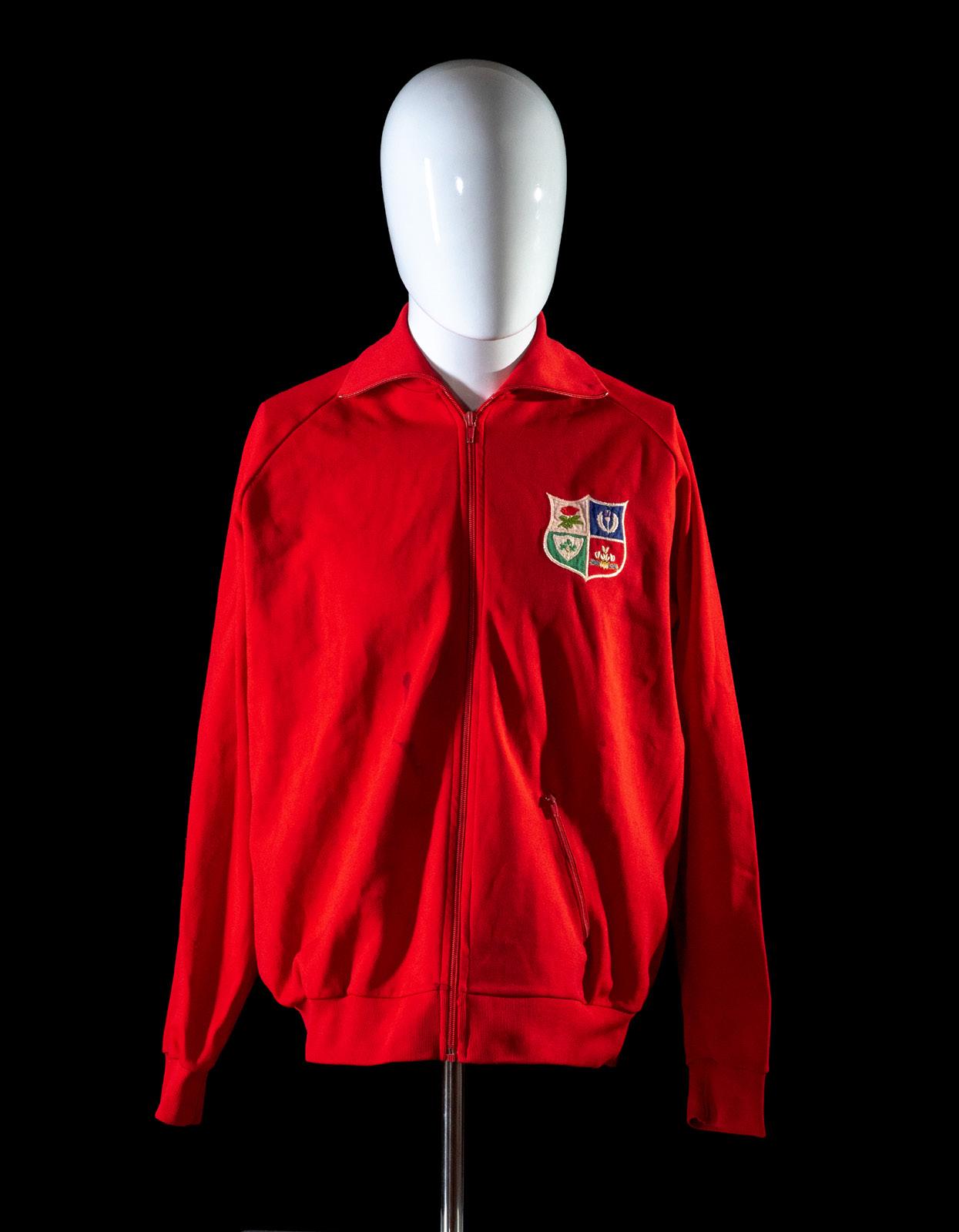
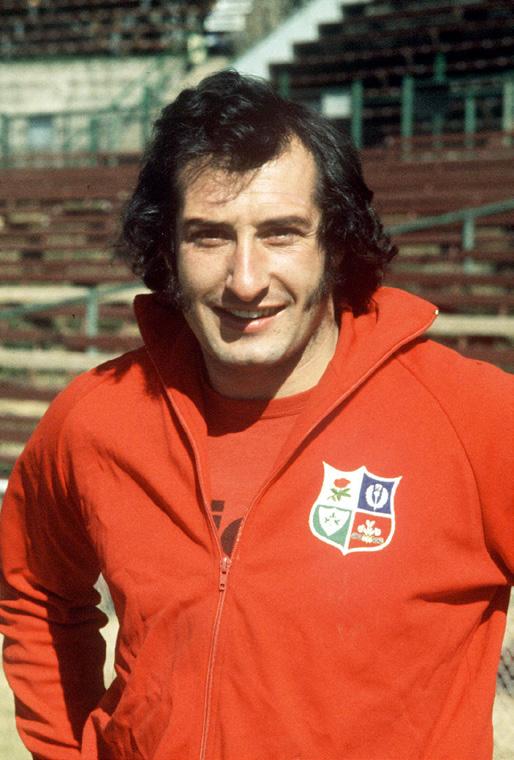
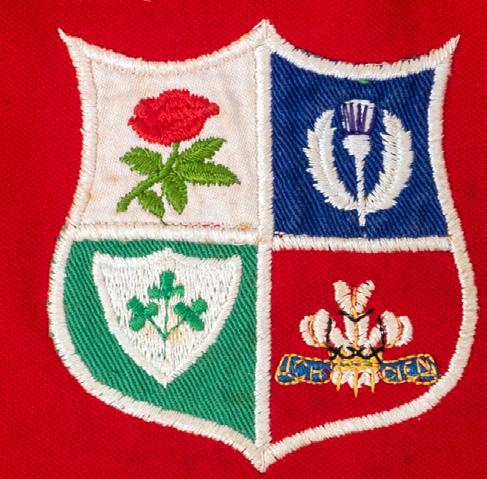
Rugby union track suit top issued to Sir Gareth Edwards
All red zipped tracksuit by Umbro with single zipped diagonal pocket, bearing Umbro and Lillywhites interior labels, the traditional British Lions four section shield applied to chest. Blemish to front.
Provenance: the personal collection of Sir Gareth Edwards CBE & family.
The
‘To prepare for the South Africa forwards we scrummaged & scrummaged! The Test team vs the Dirt Trackers. Scrum after Scrum! Syd [Millar] knew we had to physically beat the Springboks to secure our victories’.
Estimate: £500-1000
track suit used for training purposes during the series win against Springboks in 1974.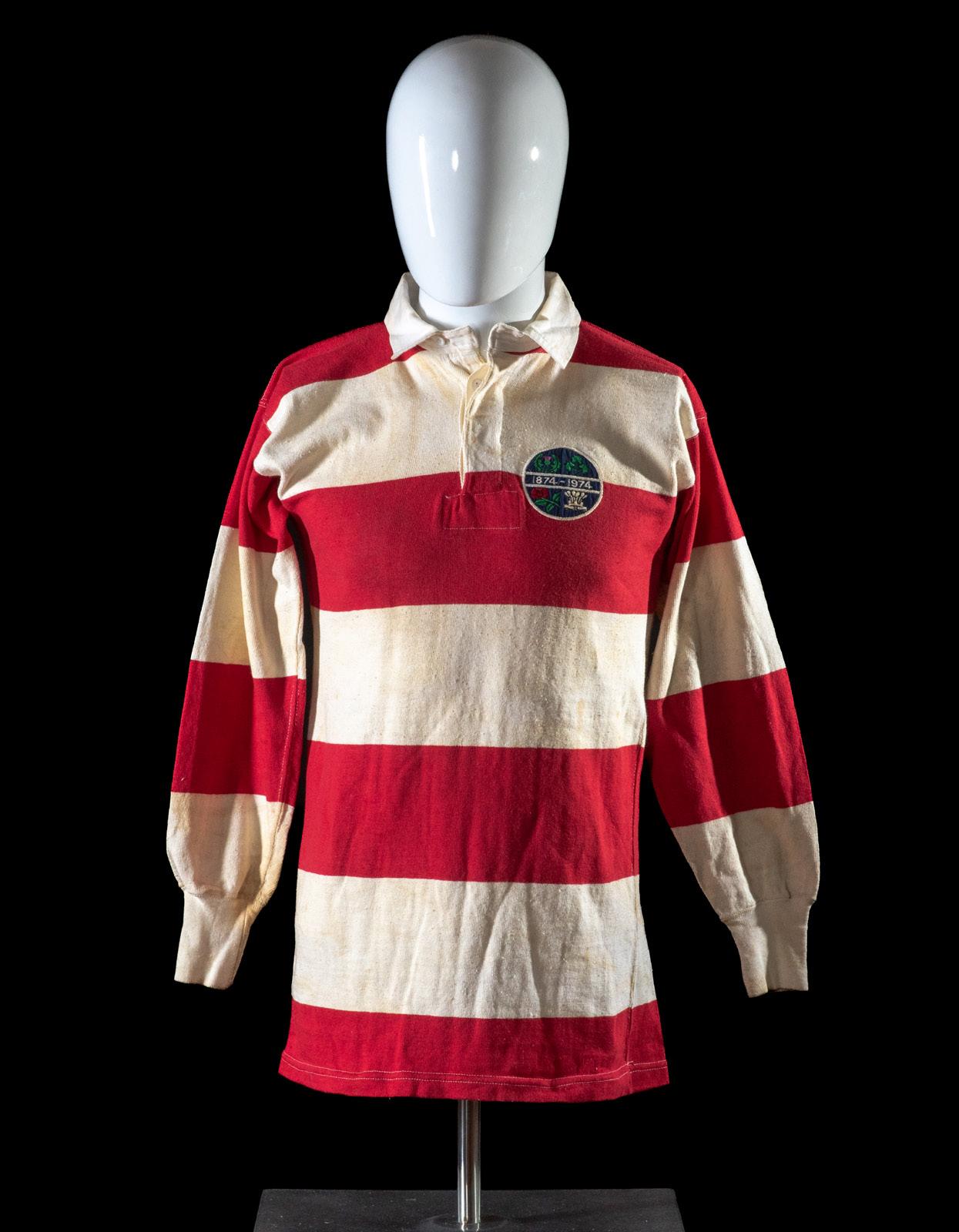
Red and white hooped jersey in original and complete condition. Bears label for Umbro (two globes), and label for supplier S S Moore, Cork. Circular badge applied to chest with embroidered crest with emblems for the four nations and 1874-1974, black plastic No.9 sewn to reverse.

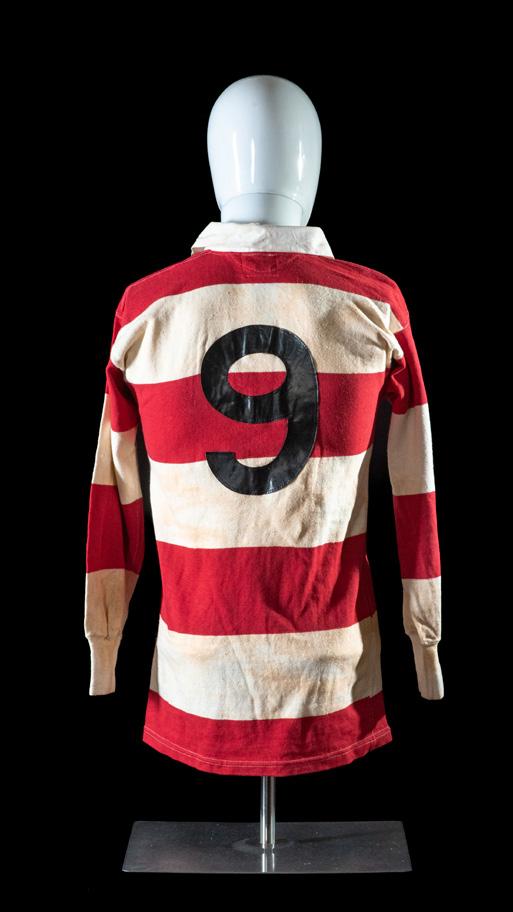
Provenance: the personal collection of Sir Gareth Edwards CBE & family.
The match was played to commemorate the Irish Rugby Union Centenary on April 19th at Lansdowne Road, Dublin. The Ireland and Scotland combined side won the tie 17-10. On this occasion Sir Gareth played alongside Neil Bennett of England at fly-half rather than Phil Bennett of Wales. Also featuring for Wales/England were JPR, Mervyn Davies, Ray Gravell and Gerald Davies who scored both his team’s tries.
‘We were proud to be part of the team- it was an honour to be chosen for a combined team and lots of fun getting to know the other players. A great experience to play in such talented company’.
Estimate: £1000-1500

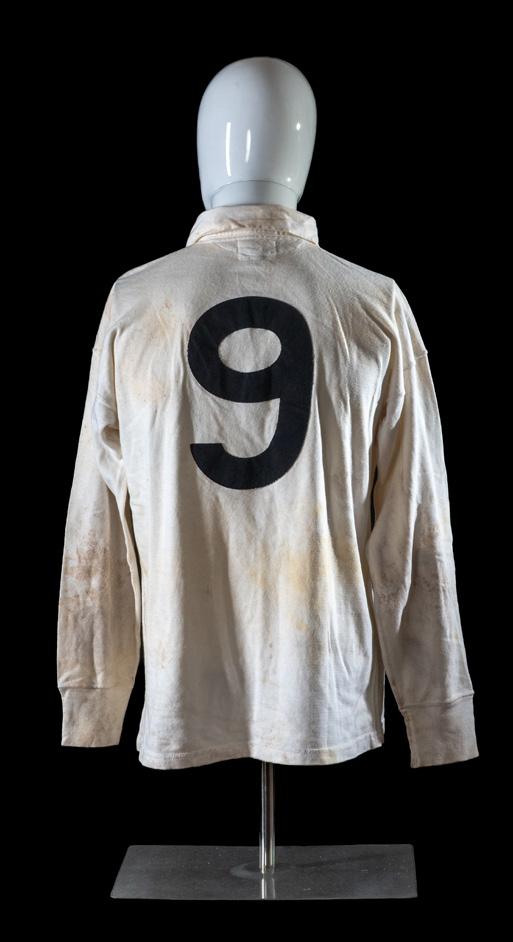
All white jersey in original and complete condition. Bears Umbro label (two globes), crest of embroidered three-head green shamrock with brown rugby ball, black IRFU above and 1874-1974 below, all upon oval badge applied to chest. Fabric black No.9 sewn to reverse.
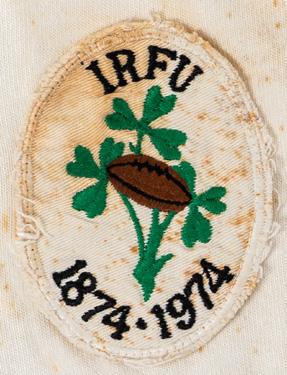
Provenance: the personal collection of Sir Gareth Edwards CBE & family.
The special match was played at Lansdowne Road on September 7th, 1974, to commemorate 100 years since the inception of the Irish Rugby Union.
The Presidents XV had a strong side out including Andy Irvine, Phil Bennett, J J Williams, and Sir Gareth Edwards who scored a try. The match finished 18-18.
The Irish players wore their traditional green and unusually for such a commemorative game were awarded a full cap for the match.
‘An
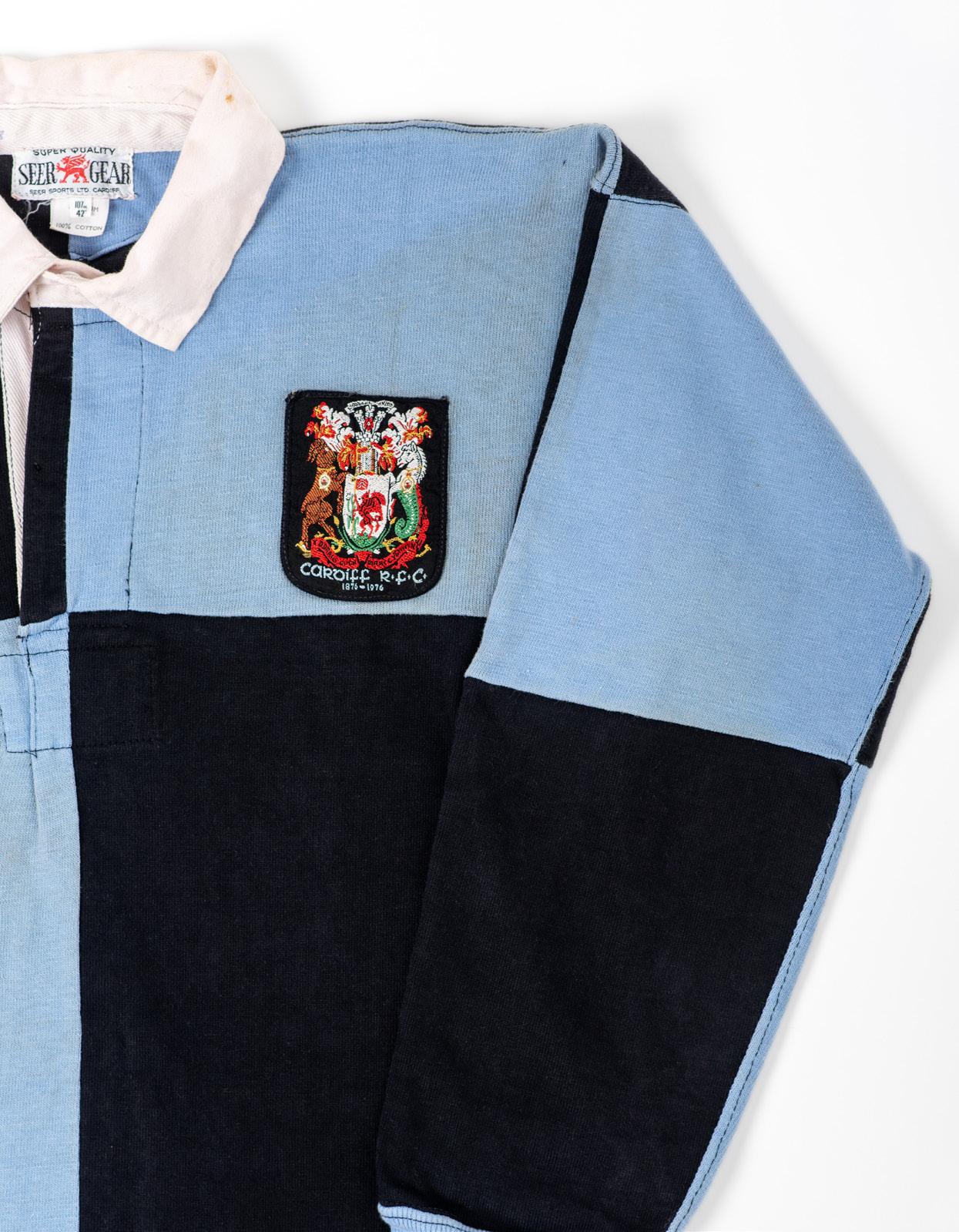
Rugby Union jersey match-worn by Sir Gareth Edwards during the club’s Centenary season
Jersey in original and complete condition. Traditional Cardiff squares, label for Seer Gear, ‘Edwards’ inscribed to interior collar, logo to right chest opposite finely embroidered traditional Cardiff RFC coat-of-arms with 1876-1976 to shield shaped badge, black No.9 to canvas square on reverse.
Provenance: the personal collection of Sir Gareth Edwards CBE & family.
Cardiff Rugby Football Club was founded in 1876, following an agreement made to amalgamate the two Victorian football clubs of Glamorgan and Cardiff Wanderers.
The first competitive game was played against Newport at Wentloog Marshes, just east of Cardiff, on December 2nd, 1876. Then home fixtures moved to Sophia Gardens before relocation to the iconic Cardiff Arms Park which was named after the nearby Cardiff Arms pub.
Initially the club strip was all black with skull and crossbones on the front, but after a few years it took a tone which was perhaps less disturbing for the mothers of potential players! So, they adopted the hooped colours for Gonvill & Gaius College (Cambridge) which are still worn today.
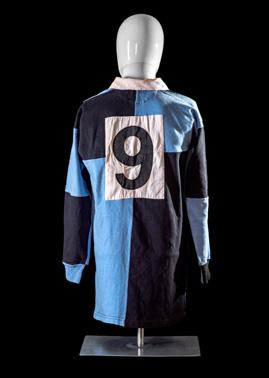
Cardiff has provided more players to the Welsh national side and British Lions than anyone else. Legends have appeared in every decade, such as Gwyn Nicholls, Rhys Gabe, Percy Bush, Wilfred Wooller, Dr Jack Matthews, Bleddyn Williams, Cliff Morgan, Gerald Davies, Barry John and of course Sir Gareth Edwards.
Gareth Edwards took the traditional route of playing in Cardiff’s trials before appearing for Cardiff Athletic at Briton Ferry in 1966, typically marked by two tries. Five months later he made his debut for the first team against Coventry. Only six games later and the young starlet was pulling on the red international jersey against France for a full cap. It was a sharp rise to the top where Gareth Edwards remained for his entire playing career.
Sir Gareth Edwards was proudly a one-club man, he played 195 games in 12 seasons for Cardiff with a fabulous try count of 67. Both club and player express how indebted they are to each other, Gareth doing so with typical humility.
‘Bill Samuel was the instigator of my association with Cardiff RFC- having played for them during his younger days. I only ever played for one club and was proud to do so. With so many outstanding players when I joined from school like Gerald Davies, DK Jones, Keri Jones in the backs and Keith Rowlands, Tony Pender, John O’Shea & Howie Norris in the pack I knew I’d made the right choice. I thoroughly enjoyed my time at this great Club.
I will always be indebted to Cardiff because the Club taught me a valuable lesson – to treat everyone as equals, just as they did themselves’.
Estimate: £1000-2000


White jersey with red Adidas stripes to sleeve, in original and complete condition. Bears labels for Seer Gear and Adidas, printed black Adidas label to right chest opposite oval badge with brown centre, embroidered with black and white version of Prince of Wales feathers and PRESIDENTS WRU XV. Red fabric No.9 to reverse.


Provenance: the personal collection of Sir Gareth Edwards CBE & family.
1976/77 was the centenary season for Aberavon RFC, located in the Welsh town of Port Talbot. The club was founded in 1876 as Afan Football Club, changing names several times before settling on Aberavon Rugby Football Club. They joined the Welsh Rugby Union in 1887. They were an especially successful club during the 1970s and in ‘77, club players Allan Martin, John Bevan and Clive Williams all toured New Zealand with the British Lions.
‘Such special matches were a feature of rugby in those days, they helped support clubs like Aberavon and were looked forward to by both players and spectators’.

International Rugby Union jersey match-worn by Sir Gareth Edwards


Jersey in excellent original condition. Bears manufacturer label with Umbro in orange diamond and ‘The Choice of Champions’, complete with original buttons, No.9, embroidered Prince of Wales feathers.
Provenance: the personal collection of Sir Gareth Edwards CBE & family.
Sir Gareth’s final match signalled a steady decline for Welsh rugby fortunes, they were not to win another Grand Slam for 27 years.
Sir Gareth won 53 caps for Wales, scoring 88 points including 20 tries. His win percentage with Wales was a superb 70% with 35 matches won, five drawn and 13 lost.
On the 18th of March 1978, ‘The Greatest Ever’ took to the pitch for his country for the final time – in front of a capacity crowd of 60,000 on his home turf at Cardiff Arms Park. Fittingly the match was against the French, who had beaten Wales when Sir Gareth won his first cap. This time Wales would win with two tries and a conversion from Phil Bennett, a drop goal from Steve Fenwick and another from Gareth Edwards. The victory sealed the Grand Slam for Wales, Sir Gareth’s third, in what was the ‘golden era’ of Welsh rugby. It meant that Wales became outright Five Nations champion for 1978. During Sir Gareth’s tenure at scrum half for Wales, they had won the Championship outright five times and were joint champions twice. Prior to 1971, Wales had not won a Grand Slam since 1952.
‘What brought us together (the Welsh team of the 1970s), fuelled our collective desire and made us the team we were was a love for the game. We were young kids who just adored what we were doing and reveled in the thrill of it all. The players in those Welsh teams had the confidence, the attitude, the belief but more than that, we loved being out there playing the game. Like good actors, the players were all comfortable with one another. There was a serious attitude when required, but it was more like a family going out to play together. That was how close we became. We all knew one another and cared for each other so that we never went out just thinking we’ve got to win this to achieve another Grand Slam or Triple Crown or Championship title. It went deeper than that for us’.
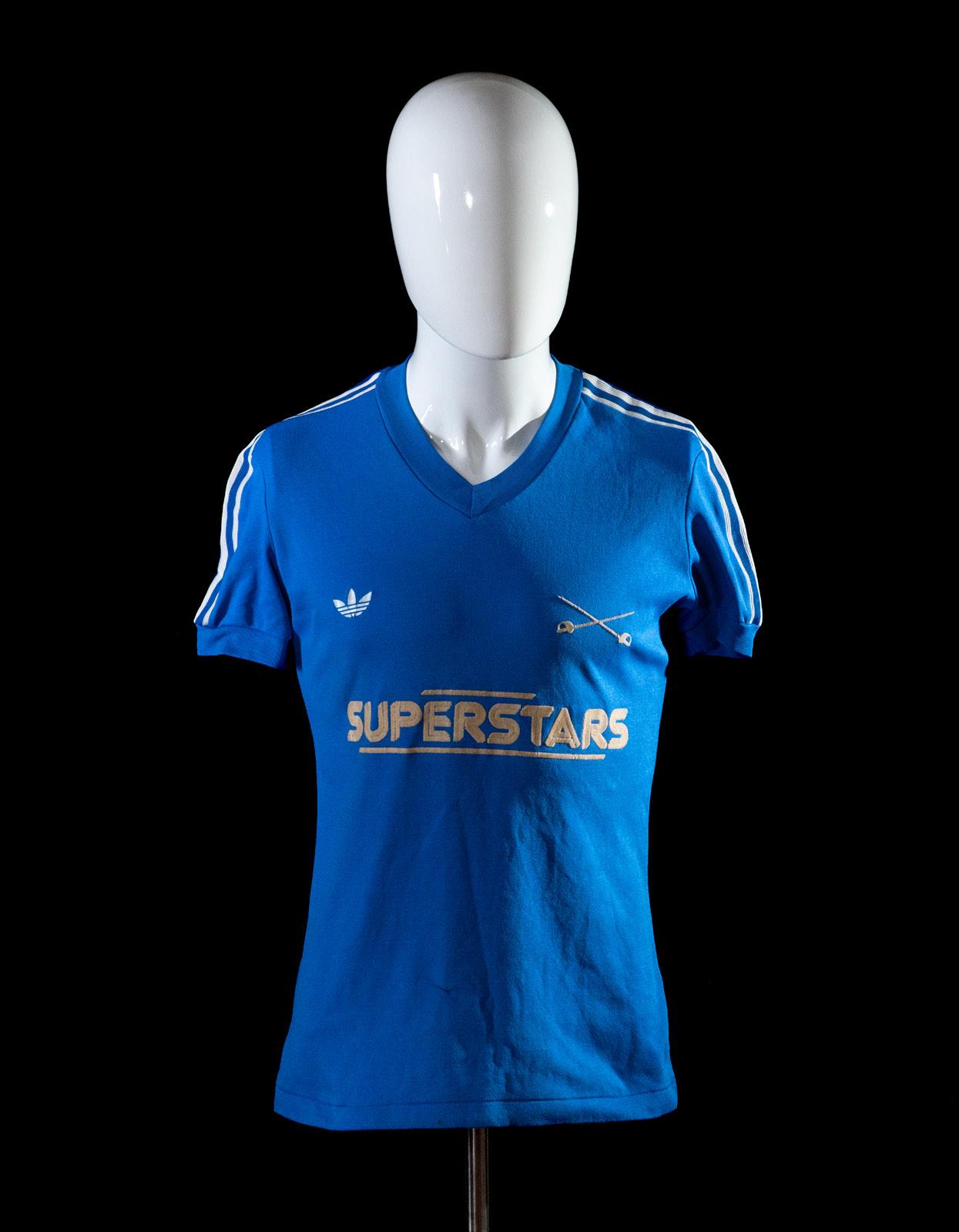
British, European & International Superstars competition-worn t-shirts by Sir Gareth Edwards
Comprising (1) blue v-neck t-shirt with white Adidas stripes to sleeves, white Adidas logo to left chest, white ‘Superstars’ in felt applied to width of chest, right chest with ‘crossed swords’ emblem (2) red v-neck t-shirt of similar design but with black details and without ‘crossed swords’ (3) green running-vest with white details, without swords.
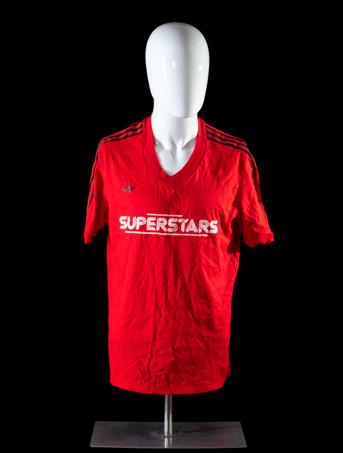
Provenance: the personal collection of Sir Gareth Edwards CBE & family.
Superstars
Superstars was a multi-discipline sports competition in which elite athletes from a variety of sports competed against each other. It was covered by the BBC in the late 1970s and 80s with presenters David Vine, Ron Pickering, and Barry Davies.

Sir Gareth Edwards competed in the 1976 UK competition in which he came overall 4th (beating fellow Welsh player JPR Williams who came in 8th place). The winner in the 1976 UK competition was David Hemery. A year later Sir Gareth travelled to Pine Martin, Georgia to compete in the first ever world Superstars championship. There was $132,000 prize money at stake for most athletes but not Sir Gareth, as an amateur.
‘I was uncertain to compete in America because Wales were playing Scotland on the Saturday! I had to go out to America on the Monday/Tuesday, compete and then return by Thursday!!! Great event, but I had to donate all my winnings to the WRU, as agreed, as I was an amateur sportsman. I returned uninjured and we won the game, in which Phill Bennett scored a great try’.
Estimate: £200-300
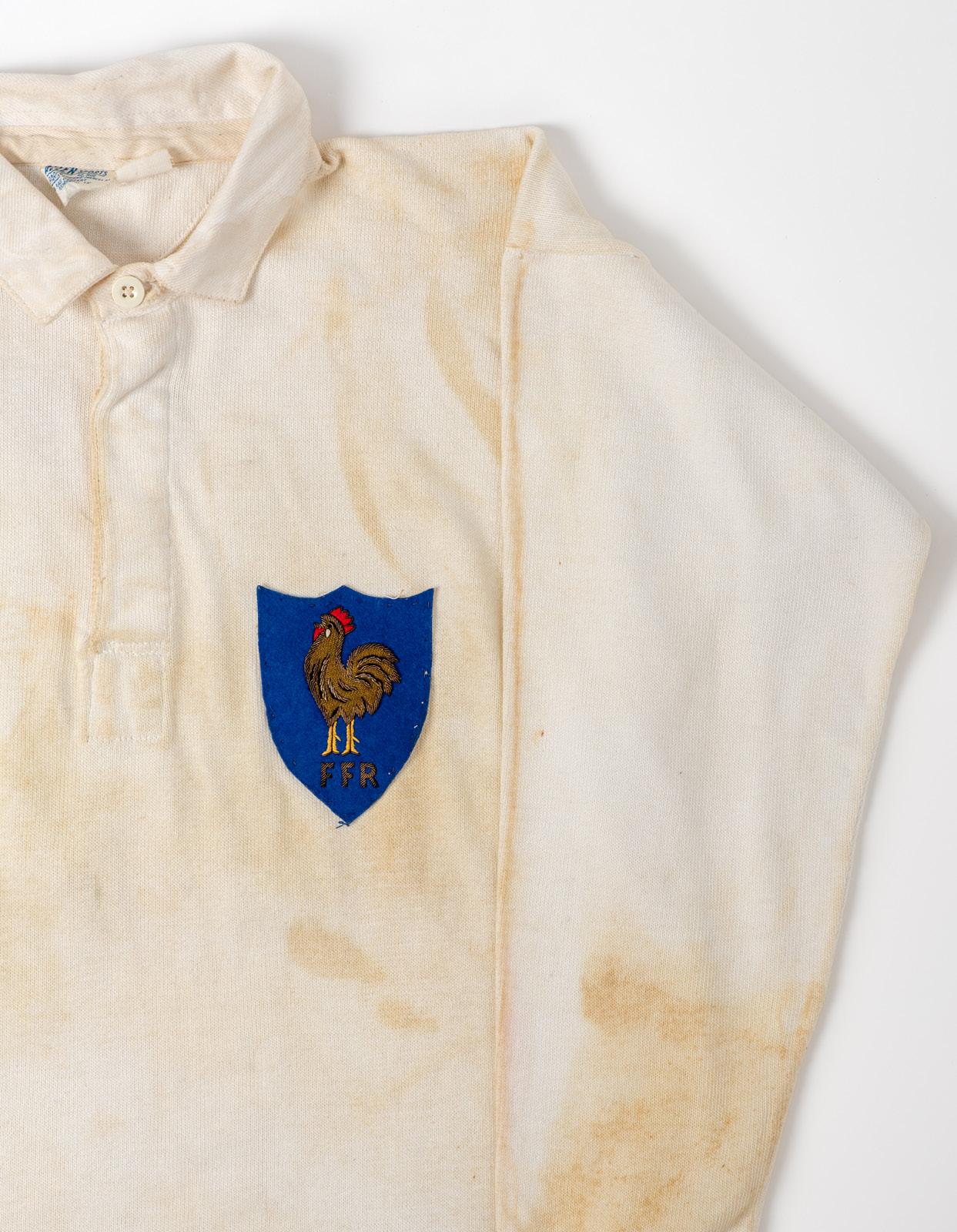
International
All white jersey in original and complete condition. Bears label for Allen Sports, Paris. Blue badge applied with braided and embroidered cockerel and FFR, black plastic No.11 as per the period.
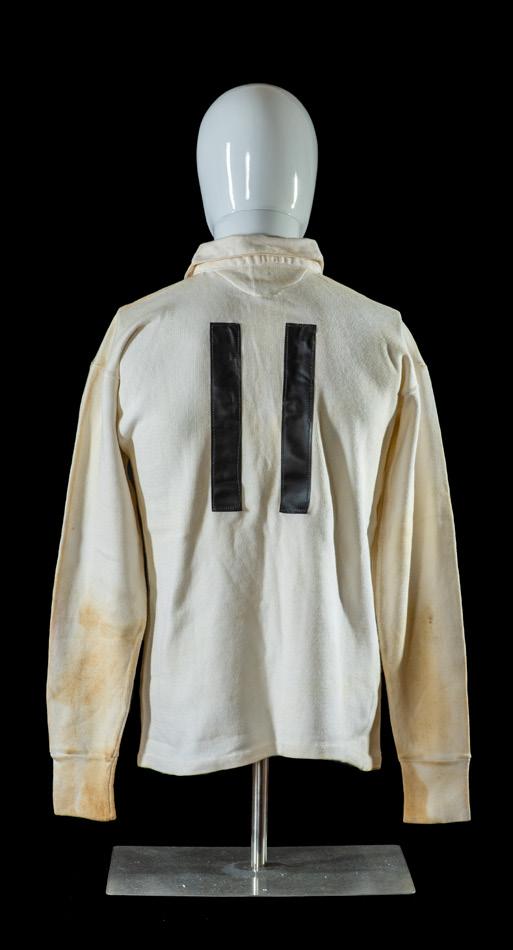
Provenance: the personal collection of Sir Gareth Edwards CBE & family.
Christian Darrouy (b.1937) was a long serving winger for France with 40 caps between 1957 and ’67 being one of the country’s best try hunters.
Wearing the French jersey, Darrouy amassed 69 points with an impressive 23 tries, 13 of which were scored in the seven Five Nations Tournaments in which he participated. Darrouy’s overall match win rate with France was a solid 62%. He was a Five Nations Tournament winner in ‘59 and in the year that he wore this jersey against Wales in 1967.
In that ’67 match France beat Wales 20-14 at Stade Olympique, Colombes, before dispensing of Ireland to be crowned champions.
The 1967 match against Wales was Sir Gareth Edwards’ first Wales cap at the age of 19. Darrouy was also awarded his first French cap at the age of 19 albeit ten years earlier. Darrouy was to bow out of international matches four games later, at the end of the season, playing against South Africa. It was perhaps because of this symmetry and affinity that Darrouy was to gift Edwards his No.11 jersey after the match.
‘After the match Stuart Watkins swapped his shirt with Darrouy to allow me to keep my first Welsh shirt and have a French shirt from my first International’.

Jersey in original and complete condition. Small Canterbury label, embroidered silver fern applied to badge and sewn to chest, cotton No.9.
Provenance: the personal collection of Sir Gareth Edwards CBE & family.
Christopher Robert Laidlaw (b.1943) played 57 matches for New Zealand, including 20 internationals, scoring three tries. He captained the All Blacks on three occasions. He made his debut for the All Blacks in 1963 on their tour of Britain and France.

Laidlaw was well-educated, he was schooled at King’s High School from 1957 to 1961, where he played in the first rugby team, he then attended Otago University from 1962 to 1966. Then in 1969, he took up his Rhodes Scholarship at Merton College, Oxford.
In New Zealand, Chris Laidlaw is as well-known for his achievements later in life just as he is an All Black. He is said to be a man with determination to stand up for what he believed was right. This determination guided him through a long and varied career as scholar, diplomat, politician, writer, and radio broadcaster and his CV includes race Relations Conciliator and Human Rights Commissioner in New Zealand.
He was an outspoken figure for the anti-apartheid movement and for civil rights which he says stemmed from the All Blacks’ 1970 tour to South Africa when his ‘social conscience was jolted’.
‘Principles are evolutionary. I went (on the tour) because I believed that it was better for us (All Blacks) to be there with a multiracial team on the field, regardless of what the South Africans were doing with apartheid.
And conversations I had there led me to believe that the next South African team to tour in 1973 would be a mixed one – but they didn’t deliver on that.
It had become clear to me that the only way to fight apartheid was to deny contact. It was a personal journey of discovery for me and I’m glad I finally made a stand’.
In 1977 during a diplomatic function in New York, Laidlaw recalled that the then NZ Prime Minister, Robert Muldoon harassed him, jabbing his finger in Laidlaw’s chest. Muldoon was angry about Laidlaw’s public comments criticising apartheid in South Africa. Laidlaw says he grabbed Muldoon by the lapels and propelled him against the wall saying, ‘If you ever touch me again, I’ll knock your teeth out.’ Muldoon glared at him, turned on his heel and walked out!
In 1967, Laidlaw was selected for the New Zealand rugby union tour of Great Britain, France, and Canada, playing 17 matches, four with Test status against international opposition. The New Zealand team finished the tour undefeated, the first time they had achieved this in the Northern hemisphere since the 1924–25 ‘Invincible’ All Blacks team. The only match they did not win was against East Wales. This jersey was worn on 11th November 1967, it was Sir Gareth Edwards’ first Wales match versus New Zealand, a match which the All Blacks won 13-6.
‘The ‘67 All Blacks were a formidable side who I played three times on their tour, for three different sides – the Barbarians, East Wales and Wales. Chris Laidlaw was the scrumhalf on each occasion. An All Black great’.

International Rugby Union match-worn scrum half jersey versus Wales
Jersey in original and complete condition. Bears label for Lillywhites. Finely embroidered English rose to square patch badge as per the period, black canvas No.9 to reverse.
Provenance: the personal collection of Sir Gareth Edwards CBE & family.
The jersey is from the period 1968-1971 and could have been worn by the following players Sir Gareth Edwards faced:
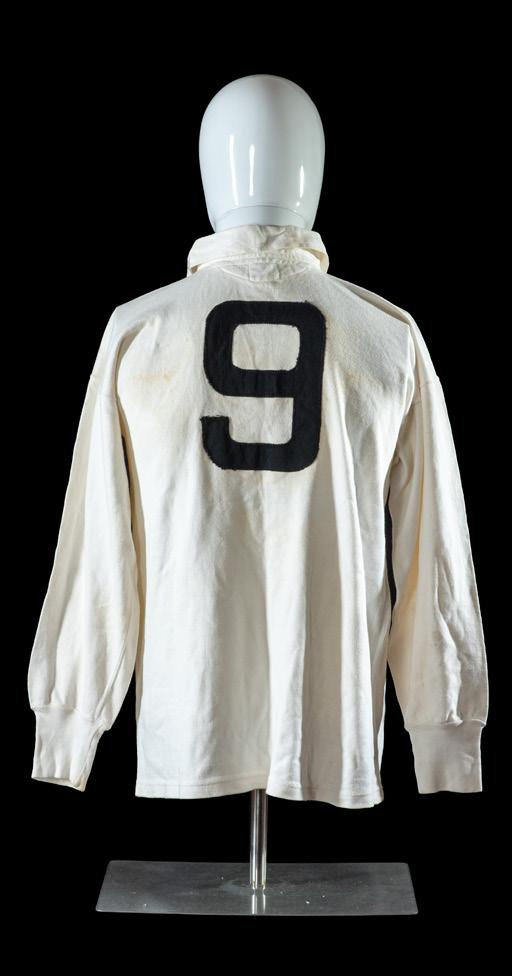
1968 - Bill Redwood (b.1939)
1969 - Trevor Wintle (b.1940)
1970 - Nigel Starmer-Smith (b.1944)
1971 - Jacko Page (b.1947)
Wales won each of the above matches except in 1968 which was drawn.
‘It seemed like I was playing against a different England scrum-half every season. They chopped and changed frequently in what was a difficult period for them - England did not win the Five Nations Championship outright during my playing career with Wales’.
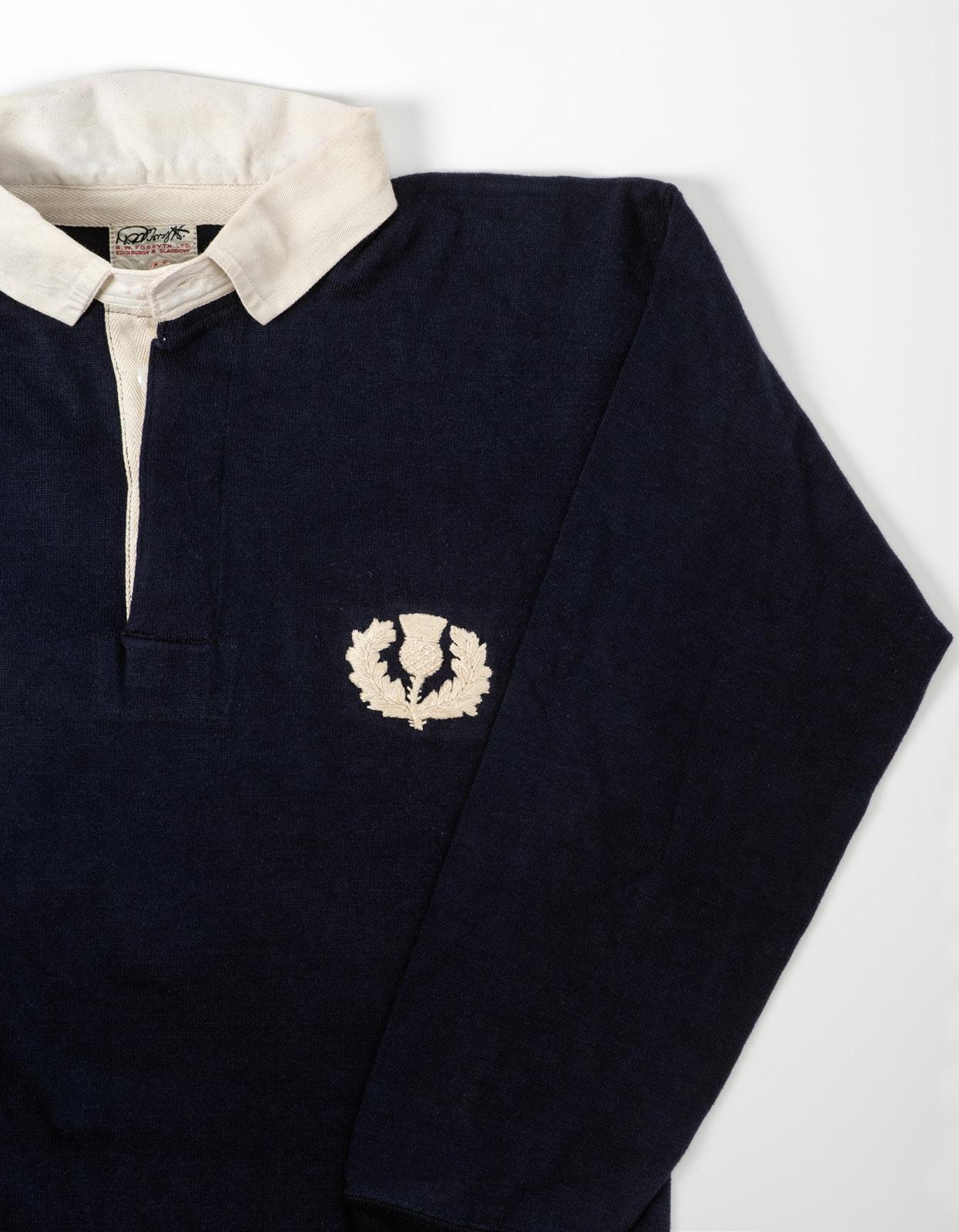
Jersey in original and complete condition. Label for Forsyth, Glasgow, embroidered Scottish Thistle, plastic No.9 sewn to reverse.
Provenance: the personal collection of Sir Gareth Edwards CBE & family.
Alexander James Hastie (1935 –2010) played 18 test matches for Scotland between 1961 and 1968. He was Sir Gareth’s opposite scrumhalf on Hastie’s final test match for Scotland on February 3rd, 1968, which Wales won 5-0, in Cardiff.

He was paired at fly-half in this match with David Chisolm, with whom he had previously recorded a run of ten international matches without defeat. Their telepathic half-back understanding was bred at Melrose RFC where they enjoyed eleven seasons together. Hastie was club captain at Melrose when they won the Scottish Unofficial Championship in 1962-63 season, and the Border League in that same year.
‘I will always remember this match as it was my first match as Captain’.
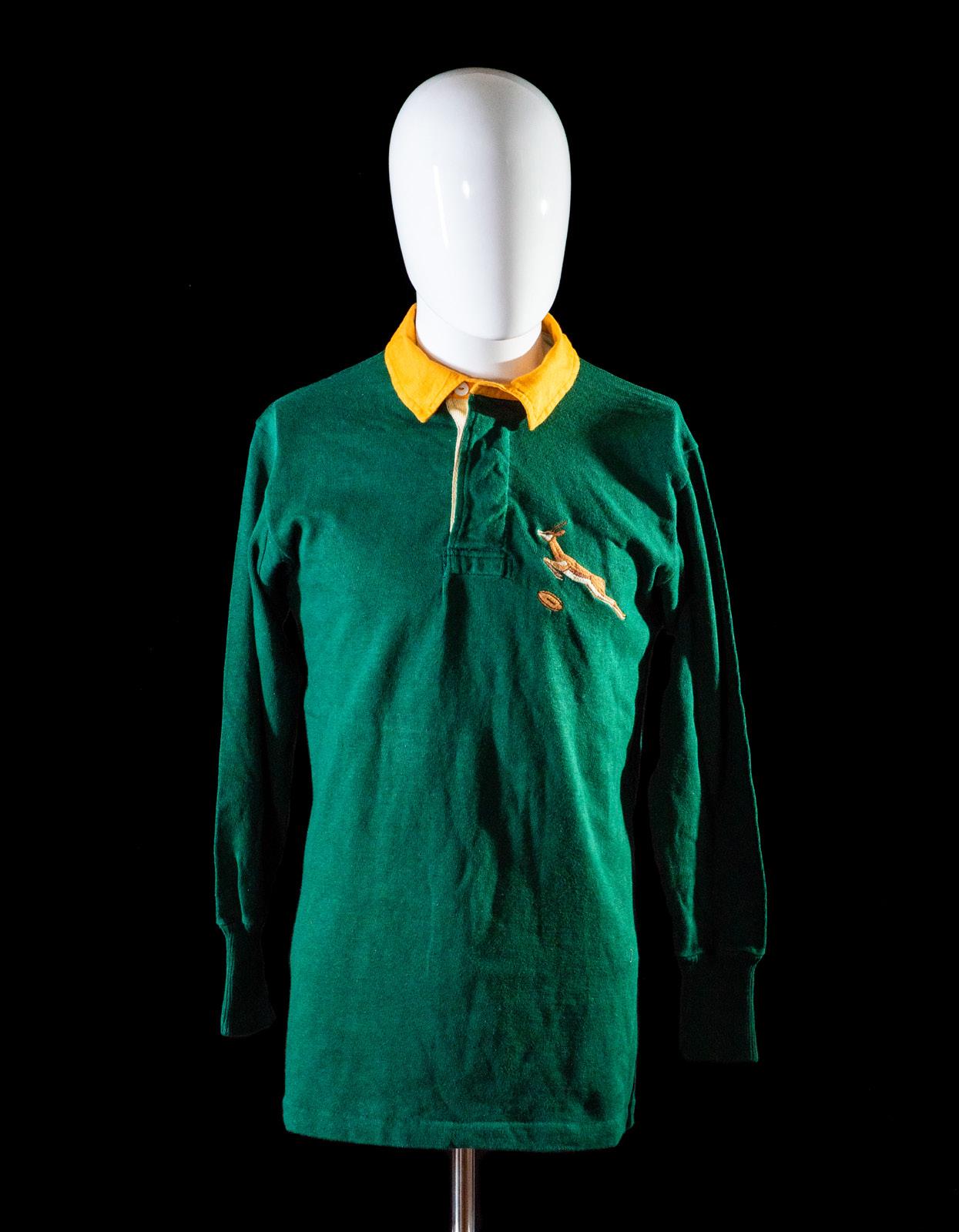

Jersey in original and complete condition, not canvas lined / quilted as per the period, bears label for Maxmore and Markhams, embroidered leaping Springbok, canvas No.9 to reverse.
Provenance: the personal collection of Sir Gareth Edwards CBE & family.
David Jacobus de Villiers (10 July 1940 – 23 April 2022) was one of the greatest Springboks, he was the dominant scrumhalf of the 1960s, playing 25 tests for South Africa between 1962 and 1970. He was captain for 22 of his caps.
De Villiers left an indelible mark on Springbok rugby but later in life was an important part of the political winds of change for South Africa, becoming a minister in the first democratically elected government from 1994, under President Nelson Mandela. He was part of a delegation from the then ruling National Party that met the outlawed African National Congress (ANC) and helped unban the organisation from politics. Earlier in his political career he was South African Ambassador to the United Kingdom.
De Villiers made his debut against the British Lions in 1962, aged 22. Out of his 25 Springbok caps, he racked up an impressive 15 wins. At 1.71m and 73kg, he was no giant but possessed a great pass, he had pace, agility, and an eye for a gap.
In 1970, De Villiers captained the Springboks for a famous 3-1 series win against the All Blacks on home soil. The scrumhalf’s final test was the 20-17 win at Ellis Park in Johannesburg to historically clinch that series.
At provincial level, De Villiers played for Boland, Western Province, and Transvaal (now Lions) before moving into politics.
The present South Africa Rugby Union President, Mark Alexander paid tribute to Dawie De Villiers;
‘He was a great servant of South Africa. To lead South Africa as long as he did in the amateur era and to hold the record for appearances as a test captain until the dawn of professionalism says everything about his stature as a player and leader. He was a great and loyal servant of Springbok rugby and we pay tribute to his dedication and the service he gave to the sport and South African life’.
Gareth Edwards became good friends with Dawie De Villiers and remembers him as one of the finest scrum-halves of his era.
Wearing this jersey, De Villiers played in all four tests in the series win over Sir Gareth Edwards’ Lions of ’68. He scored a try in the first test, and then in front of 60,000 at Ellis Park, Johannesburg in the final test, De Villiers was said to be the stand-out player.
‘Dawie and I talked a lot about his country. Conversations furthered both my rugby and political education. Dawie possessed a wonderful rugby brain. Besides that, he had the all-round footballing qualities that were prevalent in scrumhalves in those days: the ability to break quickly, pass accurately and kick with precision. But it was his tactical acumen which made him such a superb captain. Dawie had a wonderful sense of humour, and I have always enjoyed the time I have spent in his company; he has been a fine friend’.

Jersey in complete and original condition, small label for Lawsons, Cork.
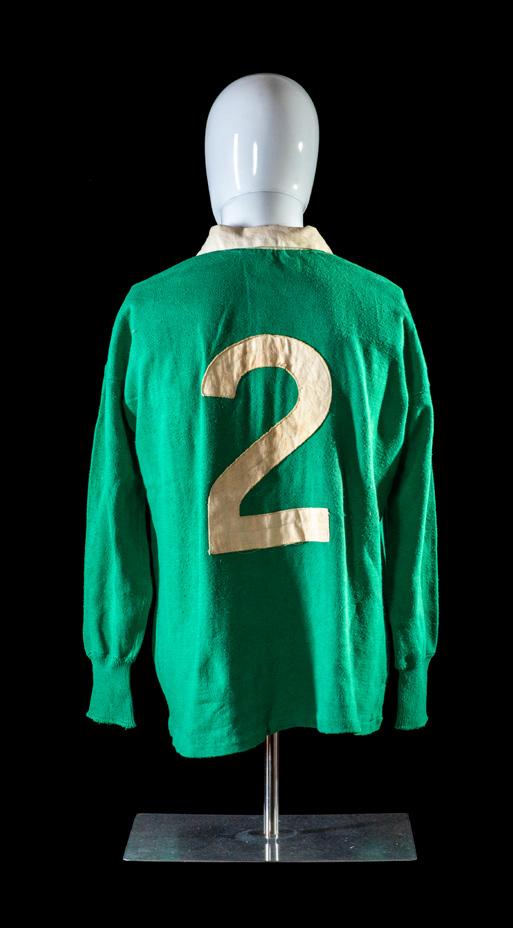
Shamrock embroidered to shield shaped white panel and applied to chest.
Provenance: the personal collection of Sir Gareth Edwards CBE & family.
Dr. Kenneth William Kennedy (1941-2022) was Ireland’s first-choice hooker for a decade, winning 45 caps between 1965 and 1975, a world record for a player in his position at the time. Known for his world-class scrummaging, Kennedy had a strong relationship with Willie John McBride, both were renowned for their toughness and skill on the field.
Kennedy toured twice with the British Lions, winning four Test caps in Australia and New Zealand in 1966. He was a back-up to Wales legend Bobby Windsor on the 1974 tour of South Africa, while also playing the unofficial role of medical officer (at a time when the squad did not have a travelling doctor).
He undertook post-graduate study in geriatric medicine at Guy’s Hospital, which led to him joining London Irish in 1968, where he played his club rugby until 1980, captaining the side from 1976 to 1979.
‘Ken was another overseas player that I got to know well and considered a friend. I have fond memories of us traveling together to Castres, in ‘87, to play a special one off ‘out of retirement’ match, as invited by Gerard Cholley’.
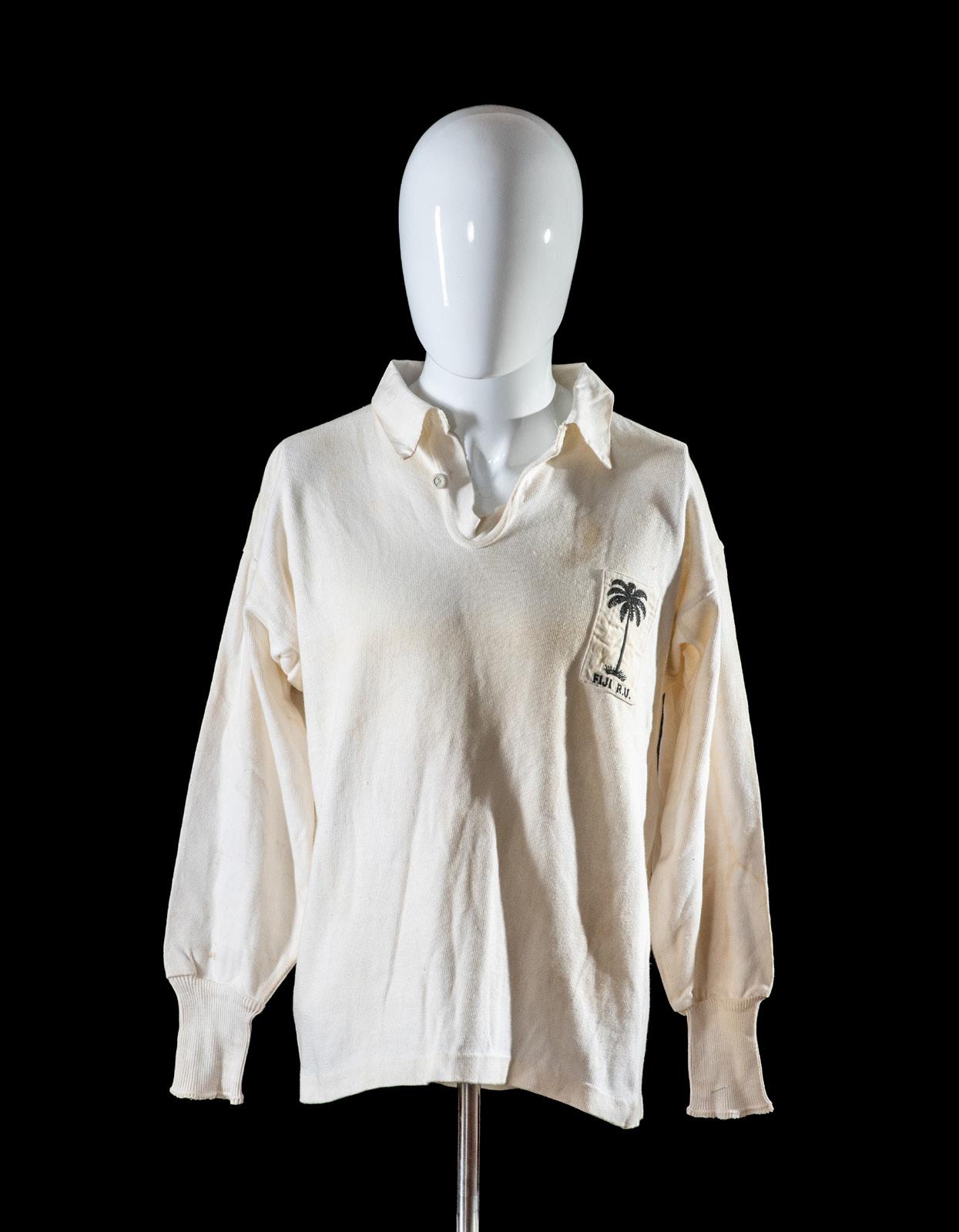
Jersey in original and complete condition, small Canterbury label, square canvas badge with embroidered black palm tree and inscribed FIJI RU, black fabric No.9 to reverse.
Provenance: the personal collection of Sir Gareth Edwards CBE & family.
Sikivou won seven caps for the Fijians between 1969 and 1973, scoring three tries.
Worn by the Fijian scrum half in the match at Buckhurst Park, Suva on 25th June 1969, with Gareth Edwards his opposite number. The match was Wales’ final game on their tour of Oceania. Wales won the match 31-11 with three Welsh tries from No.8 Dennis Hughes, one from Maurice Richards, and another from John Taylor.
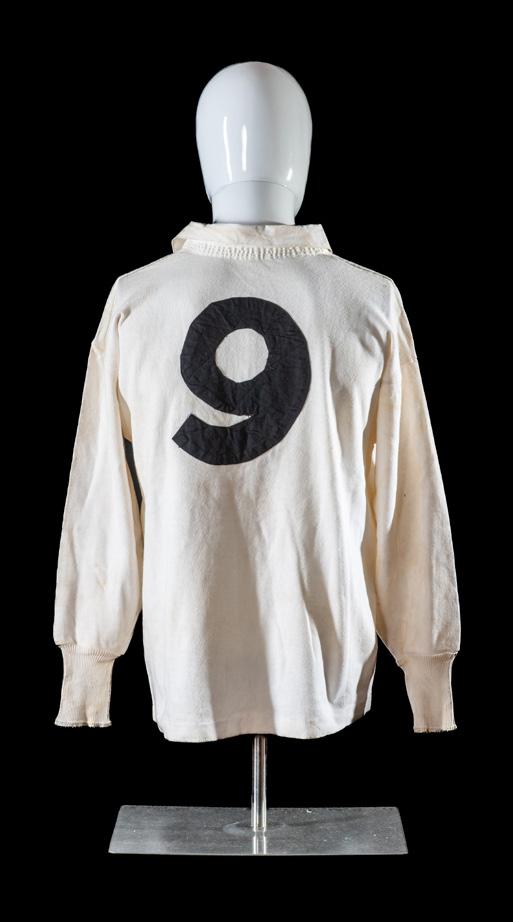
Fiji scored two tries, one of which was by Semesa Sikivou in this jersey.
Welsh matches versus Fiji were not classed as full internationals until 1985.
‘A match we had to win! In 80 degrees against Fiji, it wasn’t easy, but Dennis Hughes had an outstanding and herculean performance’.

Jersey in original match-worn and complete condition, canvas lined shoulders, original buttons, embroidered ‘Australia Rugby 1969’ badge, plastic No. 9 stitched to back, interior labels for Westmont and size 38, ‘Edwards’ faintly inscribed in ink to interior for his retention after the match on June 21st 1969.
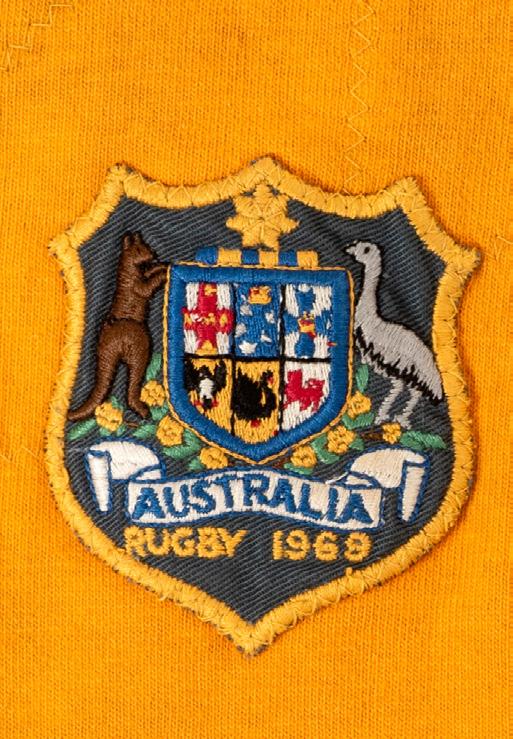
Provenance: the personal collection of Sir Gareth Edwards CBE & family.
Despite scrum half John Noel Brian Hipwell (1948-2013) suffering several nasty injuries in his career, his test record in Wallaby gold is highlighted by extraordinary longevity. He won his first cap in 1968 and last in 1982, and he captained the Wallabies in nine tests.
Born in the Newcastle suburb of Mayfield in New South Wales, Hipwell was a junior and senior player for Waratahs Rugby Club, where he was mentored by former Wallaby Cyril Burke. He was only 19 when he played his first representative match for NSW Country against the touring British and Irish Lions of ‘66. He then won his first Australian cap the following year, against the All Blacks, after regular scrumhalf Ken Catchpole sustained a career ending injury.
From then on Hipwell was a regular in the Wallabies side, touring to the UK in 1968, South Africa in 1969, France in 1971 and Europe in 1973 where he was made captain against England at Twickenham, in the absence of injured Peter Sullivan.
He went on to become tour captain of the 1975–76 tour of Britain and Ireland but suffered a career threatening cruciate ligament injury against Wales. Doctors believed that he would not play again, but three years later, in 1978, he miraculously forced his way back in the Australia side, where he played in three Tests against New Zealand.
Three years later again, he was selected for the 1981–82 Australia rugby union tour of Britain and Ireland and played in three of the four Test matches. In January 1982, at the age of 33, he played his final international game against England.
John Hipwell was one of many world-class halfbacks to emerge in this period from Newcastle, NSW. It was said that he had very few deficiencies to his game; he had an immaculate long-range pass, powerful acceleration and was

a supreme defender. He was stocky, exceptionally strong with a muscular lower body - perfect for the scrumhalf position. Without any front teeth he looked tough too, he was an intimidating character in the eyes of the opposition, while a cult figure to the fans.
His Australian team-mate Geoff Shaw described Hipwell as ‘… one of the great captains…he was very astute at the game. He knew when to get up people, and when not to get up at them’. While former World Cup winning captain Nick Farr-Jones said that Hipwell will be remembered for his grit and courage against the odds, and that he was always reminded of this in John Hipwell’s hands, ‘He had these terrible gnarly fingers…no disrespect to the forwards he played behind – often when they played the All Blacks he was going backwards – he must have had the shit kicked out of his hands’.
John Hipwell received the Order of Australia Medal in 1982 and in 2006 he was honoured in the second set of inductees into the Australian Rugby Union Hall of Fame. He died in 2013.
In 1969 Wales toured Australia, Fiji and New Zealand with four matches against regional and invitational teams and three tests. Two versus the All Blacks and one against Australia at the Sydney Cricket Ground on the 21st of June.
Wales won the Australia test 19-16 with Sir Gareth Edwards playing at scrum half opposite Hipwell. The tries for the victors were from Gerald Davies, Dai Morris and John Taylor. Australia with tries from Arthur McGill and Phil Smith. The jerseys were swapped after the match.

‘Great player was John, in his own right, especially having to live in the shadow of the great Ken Catchpole’.

International Rugby Union jersey match-worn by Ian McCrae versus Wales
Jersey in original and complete condition. Labels for Forsyth, Edinburgh & Glasgow, and for Umbro (two globes), printed Umbro logo to hem, embroidered Scottish Thistle, plastic No.9 sewn to reverse.
Provenance: the personal collection of Sir Gareth Edwards CBE & family.
Ian McCrae (b.1941) was capped 6 times for Scotland between 1967 and 1972.
McCrae was notable as the first permitted substitute in international rugby union against France, in Stade Colombes in 1969, when he took to the field to take over from the injured Gordon Connell. McCrae was a one club man who incredibly turned out for Gordonians RFC over four decades, from 1959 to the early 1980s.
He faced Sir Gareth Edwards once for Scotland in 1969 wearing this jersey, a match that Wales won 17-3 at Murrayfield with Edwards scoring one of the tries.
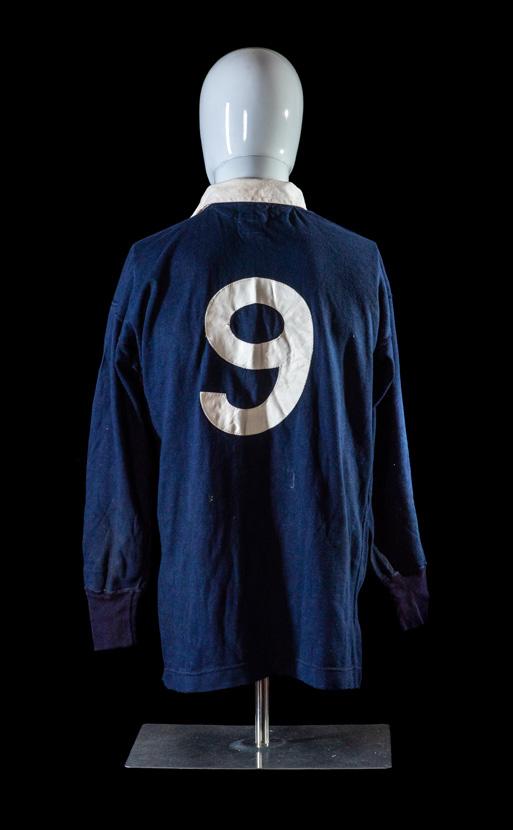
‘Clive Rowlands was the new Welsh coach and we put in a great performance to beat Scotland. It was to be a new beginning as it was a first triple crown and championship for us, with only a draw v France denying us a Grand Slam’.

Jersey in complete and original condition, bearing label for Canterbury, large single button, embroidered silver fern and cotton No.9 of the period.
Provenance: the personal collection of Sir Gareth Edwards CBE & family.
If there was one player in world rugby that could be considered Sir Gareth Edwards’ international rival, then that would be, Sidney Milton Going MBE (b. 1943).
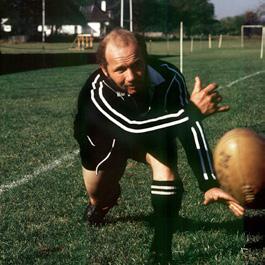
Going’s career started shortly before Edwards’ but both players retired in 1978. They were the two outstanding scrumhalves of the era and, in many eyes, they are two of the very best halfbacks that the world has seen. After scoring two tries against the French in 1968, the French proclaimed Sid Going as the greatest halfback in the world.
The Edwards-Going battles were legendary and the duels in the 1971 British Lions tour of New Zealand were a feature of the tour.
Bald headed Sid Going, with his JPR style sideburns, was an unmistakable figure on the field. He was fiercely competitive, built low to the ground with muscular strength, the result of tough farm work. His play was characterised by an instinctive dummy-pass and quick powerful surges to the line which were often unstoppable. He was known for his superb handling skills and running ability, but he was also used as a goal kicker when required and could also contribute an invaluable drop goal. ‘Super Sid’’s versatility is demonstrated in his scoring statistics for the All Blacks, playing a total of 86 matches for New Zealand amassing 164 points including 33 tries and 18 conversions, five penalty goals and a dropped goal. He was a key member of the 1972–1973 All Blacks touring side to Great Britain and Ireland and his combination with flanker and captain Ian Kirkpatrick was pivotal. The side won tests against Wales, England, and Scotland before being narrowly denied an unprecedented Grand Slam by their 10–10 draw with Ireland.
Of Māori heritage, Going played for New Zealand Māoris for twelve years and was a crowd favourite at Northland (North Auckland) where he often played alongside his brothers Ken and Brian. The brothers’ speciality was a blindside
triple-scissors movement, which almost gave Northland a late victory in the 1971 match against the touring British Lions.
In the 1977 New Year Honours, Going was appointed a Member of the Order of the British Empire, for services to rugby. He was inducted into the New Zealand Hall of Fame in 2020.
This jersey was worn by Sid Going against Wales on 14th June 1969, at Eden Park, Auckland. The match was part of Wales tour of Oceania, in which they lost to New Zealand in two tests, the first 19-0 and the second 33-12.
‘This was going to be the first of many battles with Sid. A great competitor and a wonderful scrum half’.

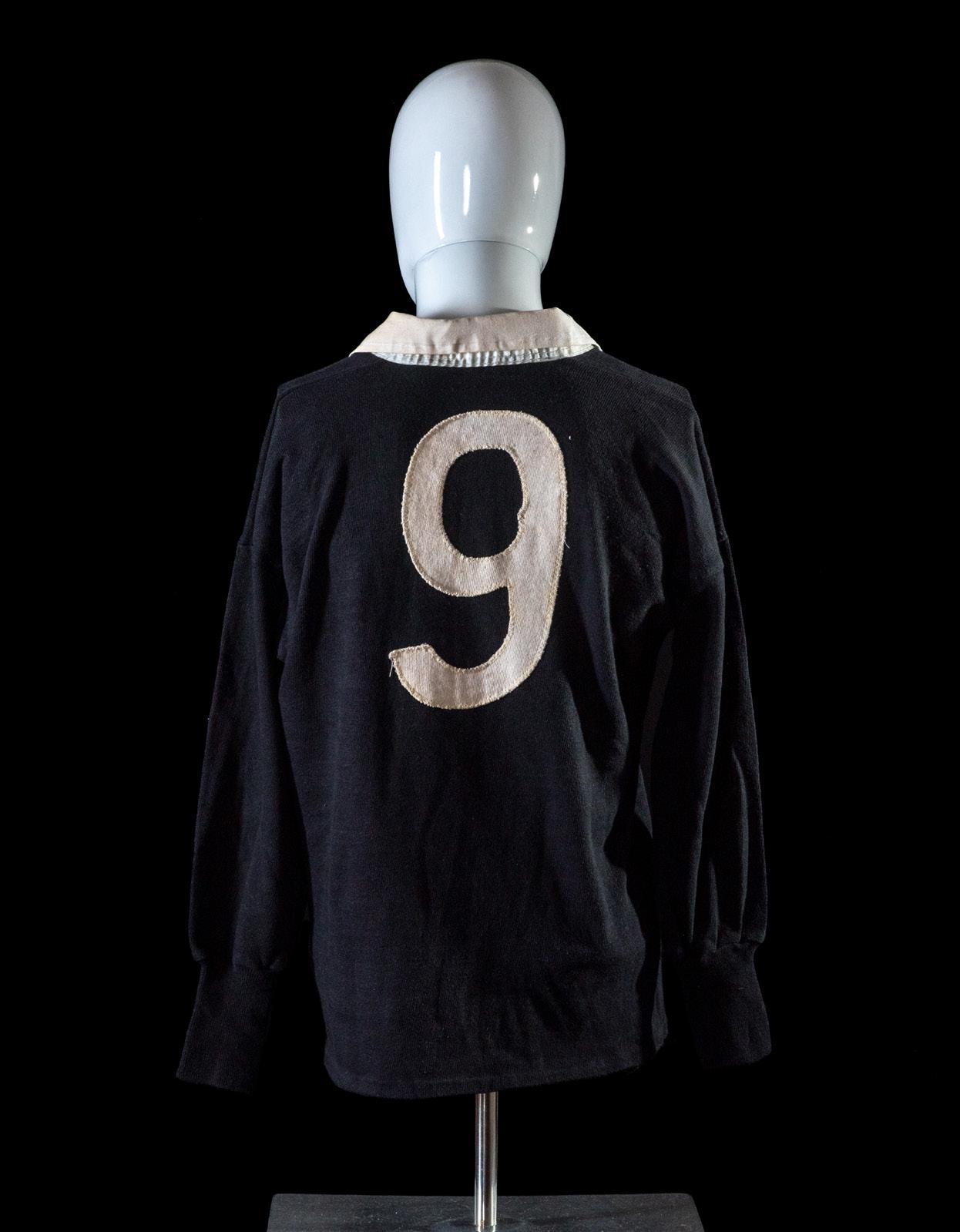
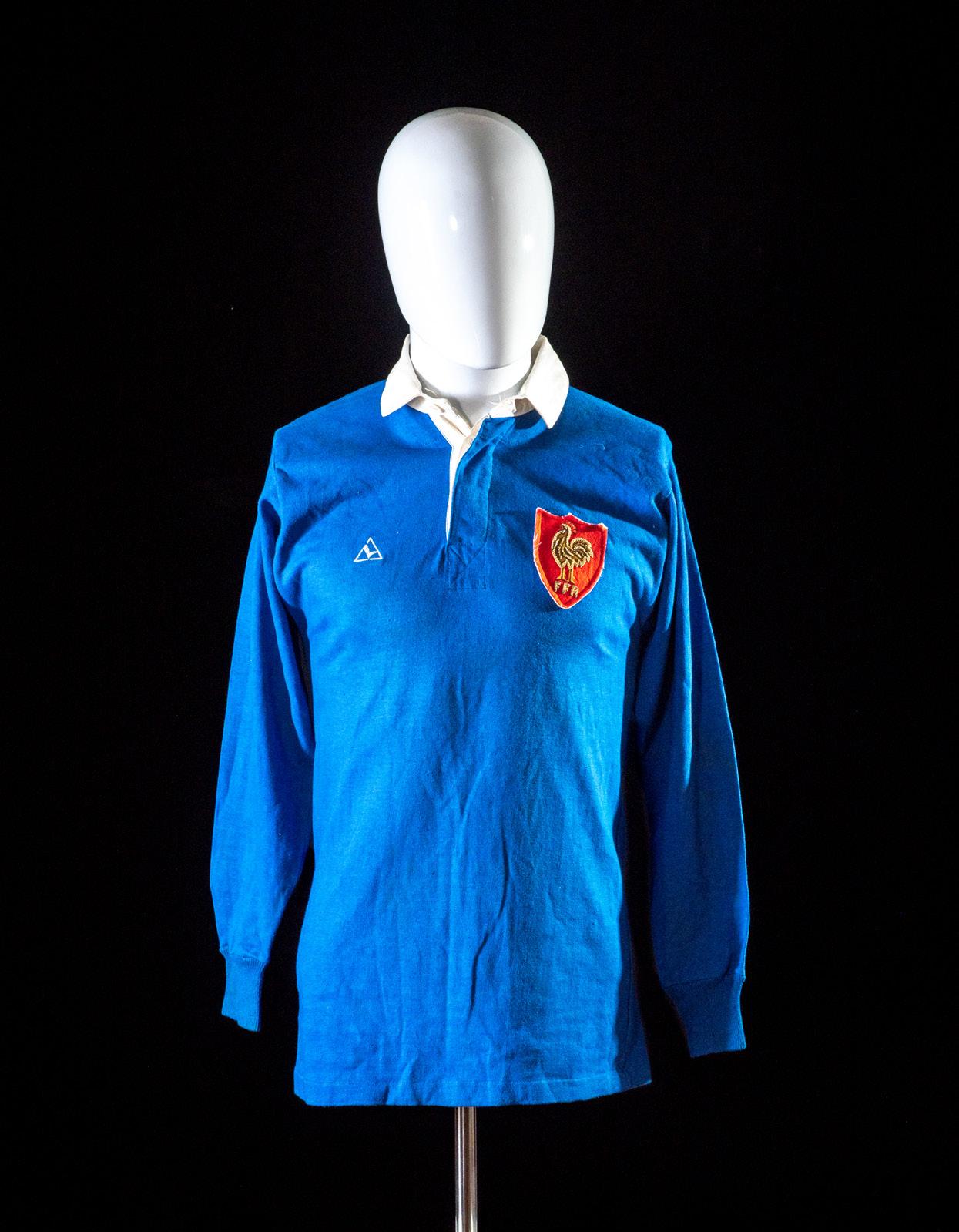
Jersey in original and complete condition. Bears small Le Coq Sportif label, and embroidered Le Coq logo to right chest opposite braided cockerel crest with FFR to a red felt badge. Plastic No.9 to reverse as per the period.
Provenance: the personal collection of Sir Gareth Edwards CBE & family.
Marcel Puget (1940 – 2021) was a French rugby scrumhalf who played 17 tests for France between 1961 and 1970. He was the France captain for the 1969 season and then the winning captain for the 1970 Five Nations Tournament.
Puget was small and slight in stature, but he compensated for his lack of physical power with game intelligence, the art of anticipation and fine ability to get his back line operating with ball in hand.
Marcel Puget toured with France to South Africa in 1967 and was captain for the 1968 tour of New Zealand.
He was a long servant with Brive and was twice a finalist of the French Championship. After his playing career Puget coached at Rodez, Limoges and Perpignan before becoming a high-level referee.
The only match Les Bleus lost in the 1970 Championship was their defeat by Wales in Cardiff on April 4th, wearing this jersey, which he swapped with his opposite number Sir Gareth Edwards, it was to be Puget’s final cap. France and Wales tied the championship in 1970.
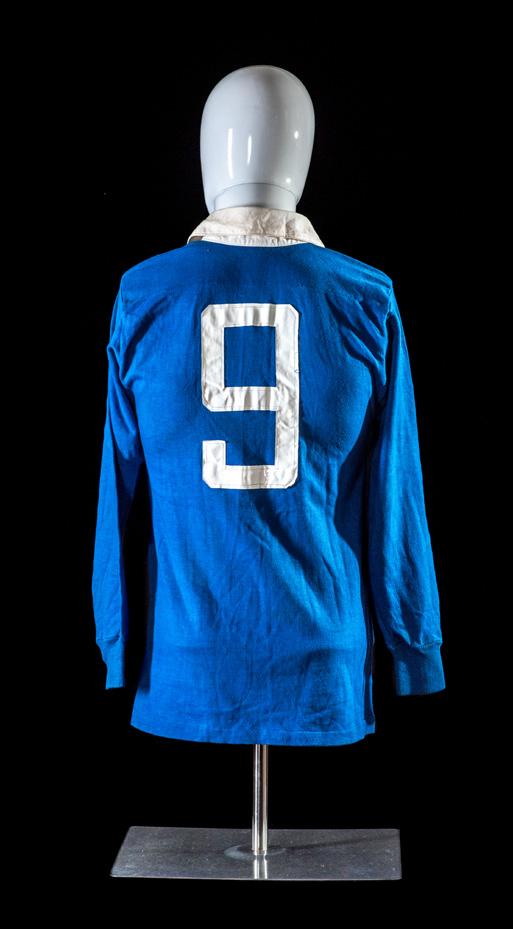
‘Marcel was captain of France when I started my captaincy of Wales - a very intelligent player’.
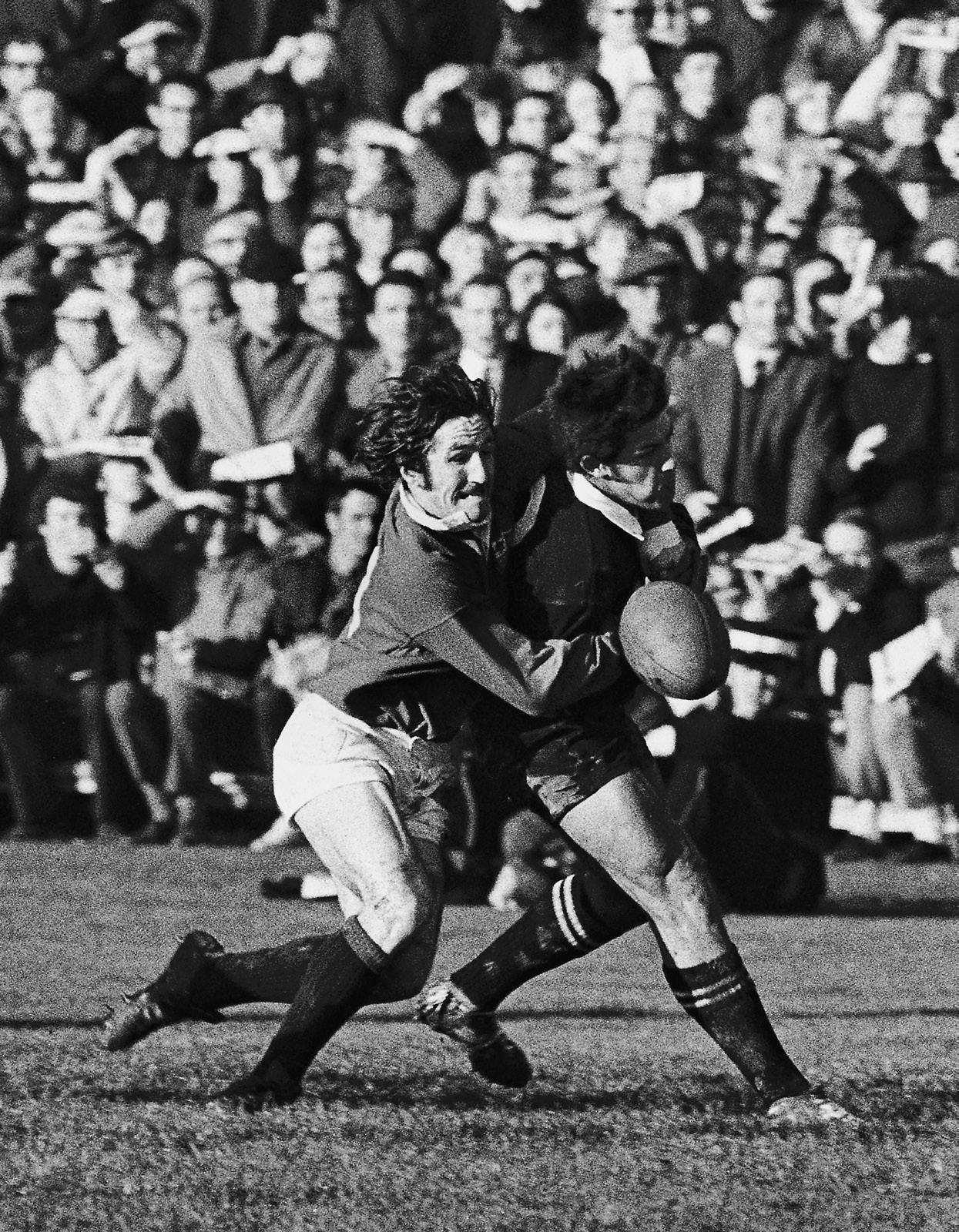

Jersey in complete and original condition. Label for Umbro (two globes version) and Lillywhites. Bears squad No.14 and British Lions crest with indigo rose to represent England, characteristic of the 1971 badge.
Provenance: the personal collection of Sir Gareth Edwards CBE & family.
Thomas Gerald Reames Davies CBE DL (b. 1945), the current WRU President, made his international debut in December 1966 against Australia in Cardiff. He was switched from centre to the wing by Welsh coach Clive Rowlands during their ‘69 tour of Australia and New Zealand, from then on, his famous side-step and acceleration led to him dominating that position for Wales for the remainder of his career. Davies was a British Lion in ‘68 and ‘71, one of a raft of Welsh players alongside Barry John, Gareth Edwards and JPR Williams who entered the folklore of both the Lions and Wales. He is perhaps best remembered for his last-gasp score against Scotland in the ‘71 Five Nations, and his three tries for the British Lions against the All Blacks in the same year, wearing this British Lions jersey.
Following his retirement from playing, Davies became a respected rugby correspondent for The Times and holds honorary fellowships from the University of Wales Lampeter, Aberystwyth, and Cardiff. Davies also served as the team manager for the 2009 Lions tour to South Africa.
The British Lions of 1971 were the first British team to win a major series abroad in the 20th Century and the only time the Lions have won a series in New Zealand. The tour was a huge success for British rugby and as a public relations exercise for the sport in the UK. The Lions succeeded in a tense and often brutal series of matches and have since been regarded as the finest British Lions team to tour, a team which struck a massive blow for Northern Hemisphere rugby.
The squad comprised 13 Welsh players, 6 from Ireland and England and 5 from Scotland. They were captained by John Dawes who had helped develop London Welsh into one of the most formidable club sides. The Lions’ coach was Carwyn James, who believed in free-flowing rugby where players could express themselves.
Carwyn James had the players to do just that with raw talent throughout; JPR Williams, John Bevan, John Dawes, Barry John, Mike Gibson, and, wearing this jersey - Gerald Davies. There were decision makers and big characters deep into the ‘71 squad, players comfortable with the ball in their hands as well as natural footballers.

The tour began inauspiciously with two matches against Australian provinces.
The first, against Queensland was but 58 hours away after flying half-way across the world. They lost 15-11. The second was New South Wales - again concerning, with the Lions scraping a 14-12 win. Their chances of glory in All Blacks territory were ridiculed by the Australian press. It was an ominous start. But the Lions needed time to find their feet (and probably shake off their jetlag). They won the next ten matches in New Zealand before the first test. Wins included Waikato, the Maoris, Wellington, and Canterbury.
It was the Canterbury match on June 19th, 1971, one week before the First Test, which is remembered for the wrong reasons. It was to be a rough-up of the Lions, known as the ‘Battle of Lancaster Park’, the ‘Game of Shame’. It was a violent affair of punch-ups resulting in broken bones, swollen eyes, and facial cuts, including a fractured cheekbone to Lion Sandy Carmichael and concussion for Fergus Slattery. John Pullin was felled by a punch from behind and Sir Gareth Edwards was floored by a rabbit punch.
The Lions tried to play the Carwyn-way and thanks to superior handling they won what was a moral victory. But they would need to finish the tour without Roy McLoughlin and Carmichael in the front-row. Second string props were flown out.
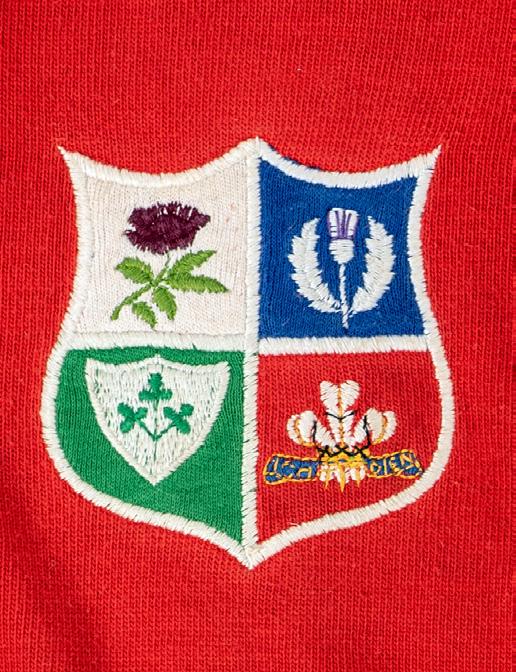
In the first test at Dunedin on 26th June, Sir Gareth Edwards sustained a leg injury and was replaced by Chico Hopkins. The Lions scraped a 9-3 win with two Barry John penalties in the second half. It was not an emphatic victory, but great for moral - the All Blacks could be beaten!
In the second test Edwards had recovered and it was more of an open affair. Burgess scored the first try for New Zealand, Gerald Davies wearing this jersey scored a try in reply. Then Sid Going scored from a ruck. In the second half New Zealand
were awarded a penalty try, Burgess scored the second of the day and then Ian Kirkpatrick scored a famous solo try. New Zealand were cruising 22-6 but there was a spirited revival from the Lions, and they managed to claw back to 22-12, again through Gerald Davies. But the final score was 22-12 to New Zealand and the All Blacks had stopped the Lions run of 15 games without defeat.
There were four more Lions’ wins including Hawke’s Bay who put a cynical performance to match the Battle of Lancaster Park, this time Pullin was badly hurt from a punch. But Gerald Davies and Barry John tormented the opposition with skill and flair. Davies scoring four tries in the game.
The crucial penultimate third test was at Wellington on 31st of July. The Lions needed to win to give them the chance of a series victory. The wind was strong in Wellington, and having won the toss, the Lions opted to use the elements. It was a good decision, with Barry John executing a long drop goal in the third minute to raise the Lion’s tails. Later in the game Gerald Davies went over for a try after an All Blacks’ lineout blunder. Barry John scored another and the Lions won 13-3 –they could not now lose the four-match series.
An All Blacks victory in the final test at Eden Park, Auckland, on August 14th would draw the series. It was a tense affair, without much flowing running rugby. The All Blacks scored a converted try first, they then kicked a penalty and as half-time drew nearer, the result was looking ominously in their favour. But the Lions rallied, Barry John scored a penalty, Peter Dixon scored a try, Barry John converted. The game was drawn 8-8 when the half-time whistle blew. After the break, Barry John scored another penalty, New Zealand replied with the same and then with 8 minutes to go JPR Williams scored a brilliant drop-goal from 40 metres - the defining moment of the tour. In the dying moments New Zealand struck back with another penalty to draw the match 14-14 but it was not enough to save their series. A series victory for the Lions.
The Lions had won their first series in NZ and would return to Heathrow to thousands of fans as history makers and architects of a monumental step forward for home nations rugby. It was a glorious tour which helped rugby union gain appeal to the British public.
The Lions of ‘71 destroyed the aura of invincibility of the All Blacks and they’ll be remembered for the intention to play the Carwyn James-way in utilising their exciting backs. Clem Thomas wrote ‘I am often asked, and indeed I often ask myself, which was the greatest team, 1971 or 1974….it is my opinion that the 1971 Lions had backs who were without equal in my experience. Never did I see more consummate play from backs, with such unparalleled mastery of the basic skills’.
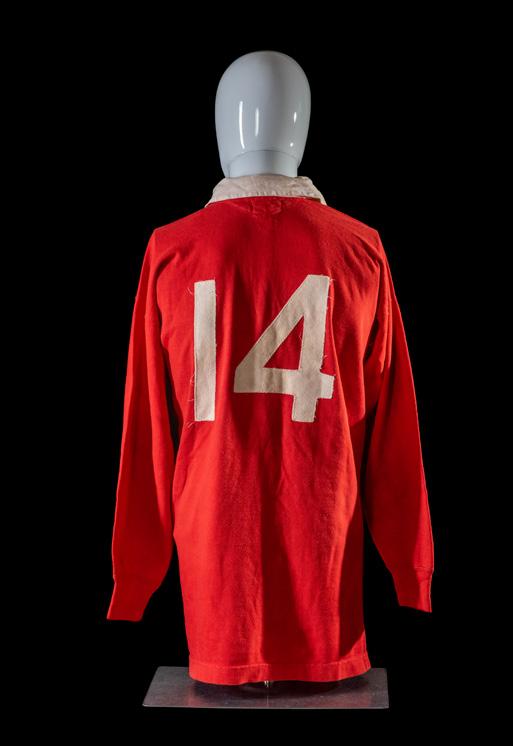
Sir Gareth Edwards regards Gerald Davies as one of his favourite players of all time.
(Gerald is) ‘..admired and remembered for his great attacking play and for scoring some fantastic tries. He was also a tenacious tackler. It didn’t matter how big they were, very few people got past him. When, you had someone like him in your side, you always felt he could create something even in an apparently hopeless situation. It was Clive Rowlands who changed him from a centre to a wing in 1969 and his renowned ability to side-step with such brilliance was a devastating part of his weaponry on the wing. What made him so dangerous to opponents was that when he side-stepped, he hardly changed pace. Indeed, it almost seemed as though he went faster’.

Jersey in original and complete condition. Bears Umbro (two globes) label, thick cotton Scottish thistle to chest, No.15 in plastic sewn to reverse.
Provenance: the personal collection of Sir Gareth Edwards CBE & family.
Andrew Robertson Irvine MBE (born 1951) vies with Ken Scotland, Gavin Hastings, and Stuart Hogg for the title of Scotland’s greatest ever fullback. For Scotland he won 51 caps, scored ten tries, was captain 15 times and scored 250 points. Polls have voted Irvine Scotland’s greatest player.
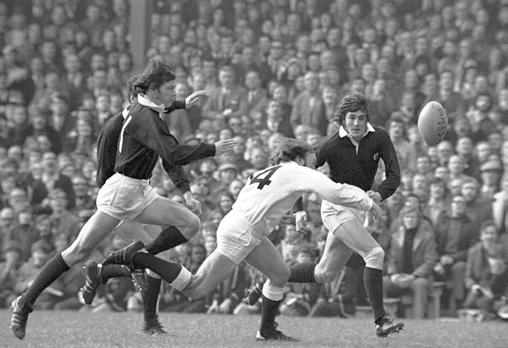
His first Scotland cap was against the All Blacks in 1972 and his last international appearance was against Australia in 1982. Irvine was awarded British Lions caps against South Africa in 1974, New Zealand in 1977 and South Africa in 1980. On the 1974 tour, he scored, a surely unassailable, 156 points in fifteen games despite JPR Williams’ presence restricting him to two Test appearances on the wing.
Irvine was more than a sharpshooter with his right boot; he was known for his explosive pace and incisive running and was probably one of the best attacking full backs of the 1970s. Later in life he became president of the Scottish Rugby Union and was awarded an MBE in 1979, for services to Rugby Football in Scotland. In 2002, Andy Irvine was inducted into the Scottish Sports Hall of Fame and inductee of the International Rugby Hall of Fame.
The match was played at Murrayfield in the Five Nations Championship, on February 3rd, 1973. Scotland managed a narrow home victory with the score 10-9.
Reigning champions Wales were pitched as clear favourites before the match, but the Scottish defence shut out the Welsh star-studded backline in a monumental display of backs-to the-wall rugby. The following day, in view of the Herculean effort from the Scottish defence and Irvine’s ‘impeccable positioning’ to scrape a victory, the newspaper headline
famously read ‘The Mighty Mouse that Roared’. It certainly was a special victory for the underdogs considering Wales’ reputation. The result contributed to the strange conclusion of all five nations tying the championship at the end of the season.
‘
One of frustration! A game we could have wonbut didn’t deserve to! Scotland frustrated us at the scrum and lineout. As usual a tough encounter. Disappointed but no complaints’.

International Rugby Union jersey match-worn Frank
Jersey in complete and original condition. Bears label for Umbro (two globes), printed Umbro to hem, maple crest badge emblazoned with ‘CANADA’ in yellow on black ribbon, black fabric No.9 to reverse.
Provenance: the personal collection of Sir Gareth Edwards CBE & family.
Francis ‘Frank’ Deacy (1945-2008) was born in Galway, Ireland in 1945, he went on to play scrum half for his school, his local Galway club and university. Emigrating to Newfoundland in the early ‘70s, Deacy became one of the founding members of the Newfoundland and Labrador Rugby Union clubs as well as Swilers Club RFC in St Johns, Newfoundland. He was a teacher in Witless Bay when he received the call up for the match against Wales XV.
Deacy, who died at the age of 68, was one of the major driving forces behind the development of rugby in Canadian’s Eastern Seaboard, he was said to be dedicated to the sport of rugby union and a major influence in the commencement of the women’s game in Canada.
This jersey was worn by Deacy against a selected Wales XV at the Varsity Stadium, Toronto on June 9th, 1973.
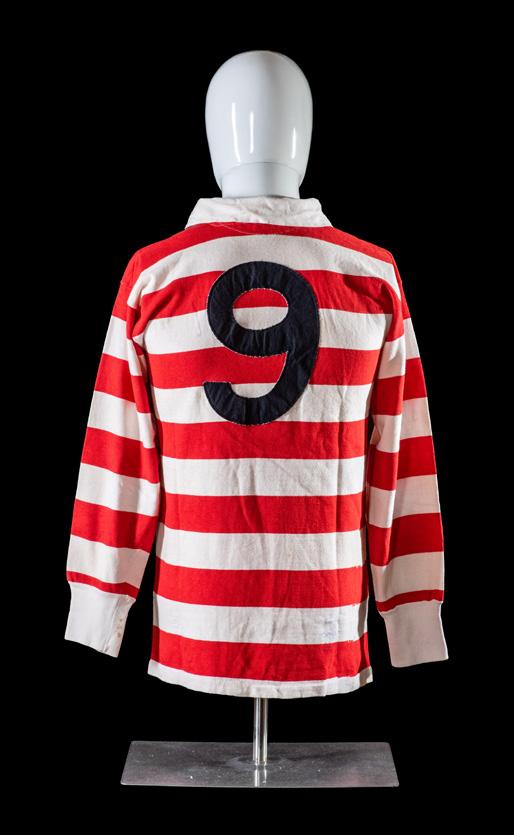
Welsh matches against Canada were not at this time categorized as Tests - Welsh players did not receive a cap against Canadian opposition until the 1987 inaugural World Cup. Nevertheless, the team to take on Canada in ’73 was full of star names and prodigious Welsh talent, including Phil Bennet, JPR Williams, Mervyn Davies and Sir Gareth Edwards. Wales won the match 58-20.
‘Although not a test match in name, the Canadians were a formidable opponent and we had to be at our very best to beat them. This match and the tour helped form the Welsh team for the next couple of seasons’.

Rugby Union jersey match-worn by Sir Colin Meads
Red jersey with white collar in complete and original condition. Bears label for Canterbury, embroidered leaping lamb to red canvas outline badge applied to chest, white cotton No.5 to reverse. A few marks and small hole noted and ‘Barbarians 1’ inscribed to back of collar. Possibly faded as though it may have been used after the match, perhaps worn at the Meads’ farm.
Provenance: the personal collection of Sir Gareth Edwards CBE & family.
Sir Colin MeadsThere is no figure more iconic in rugby union than Colin Meads (1936-2017), one of the finest rugby players ever seen. In 1999 Meads was named New Zealand rugby player of the (20th) century, a huge accolade in a country which breathes rugby union.
Meads made his test debut against Australia in 1957 and went on to play 133 All Blacks matches, including a then record 55 tests until his final appearance in 1971. These are remarkable statistics in an era when the All Blacks seldom played more than four tests a year. Colin Meads was inducted into the International Rugby Hall of Fame in its inaugural year, alongside Sir Gareth Edwards.
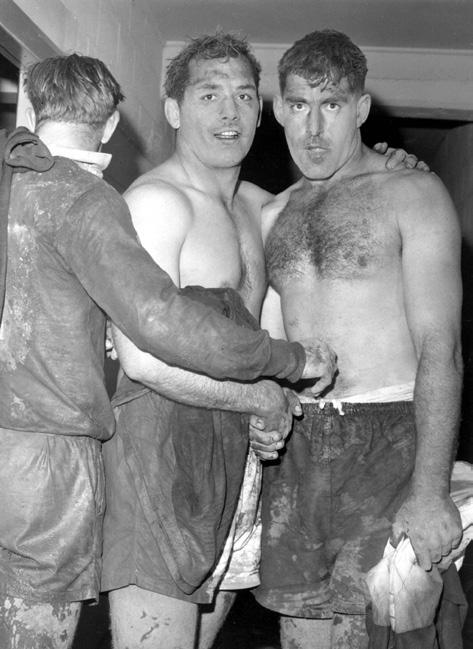
He was a sportsman who defined the spirit of New Zealand and embodied the best qualities of an All Black: he was tough, uncompromising, loyal, and humble. In a relatively young nation, he helped to define qualities which were seen to be essential to the New Zealand character.
Colin Earl Meads was a descendant of three generations of sheep farmers. He was born in Cambridge, in the Waikato region of New Zealand’s North Island. When he was 7, his parents moved to a hill farm in the rugged King Country, in the heart of the North Island. As a child, Meads contracted scarlet and rheumatic fevers, which left him so weakened that he was taught to knit lest his hands become deformed.
Nevertheless, the young Mead was hardened by farming life and developed great strength, stamina, and toughness. He played his entire club career for Waitete club and amassed 139 appearances for King Country province.
He played rugby with incredible skills for a large lock forward and was said to have revolutionised forward play by running the ball. More crucially he had enormous will to win that inspired his teammates. Yet he was uncomfortable with fame, describing
© Colorsport
himself as a ‘country hick in the big time’, he always saw himself as a father first, a farmer second and an All Black incidentally. Meads was nicknamed “Pinetree” by teammate Kevin Briscoe during a Japan tour with the under-23 team in 1958. The sobriquet stayed with him for the rest of his life, epitomizing his strength, presence, and indomitability. In 1972, he broke his back in a car crash and his body was encased in plaster but incredibly he was back on the field within five months.
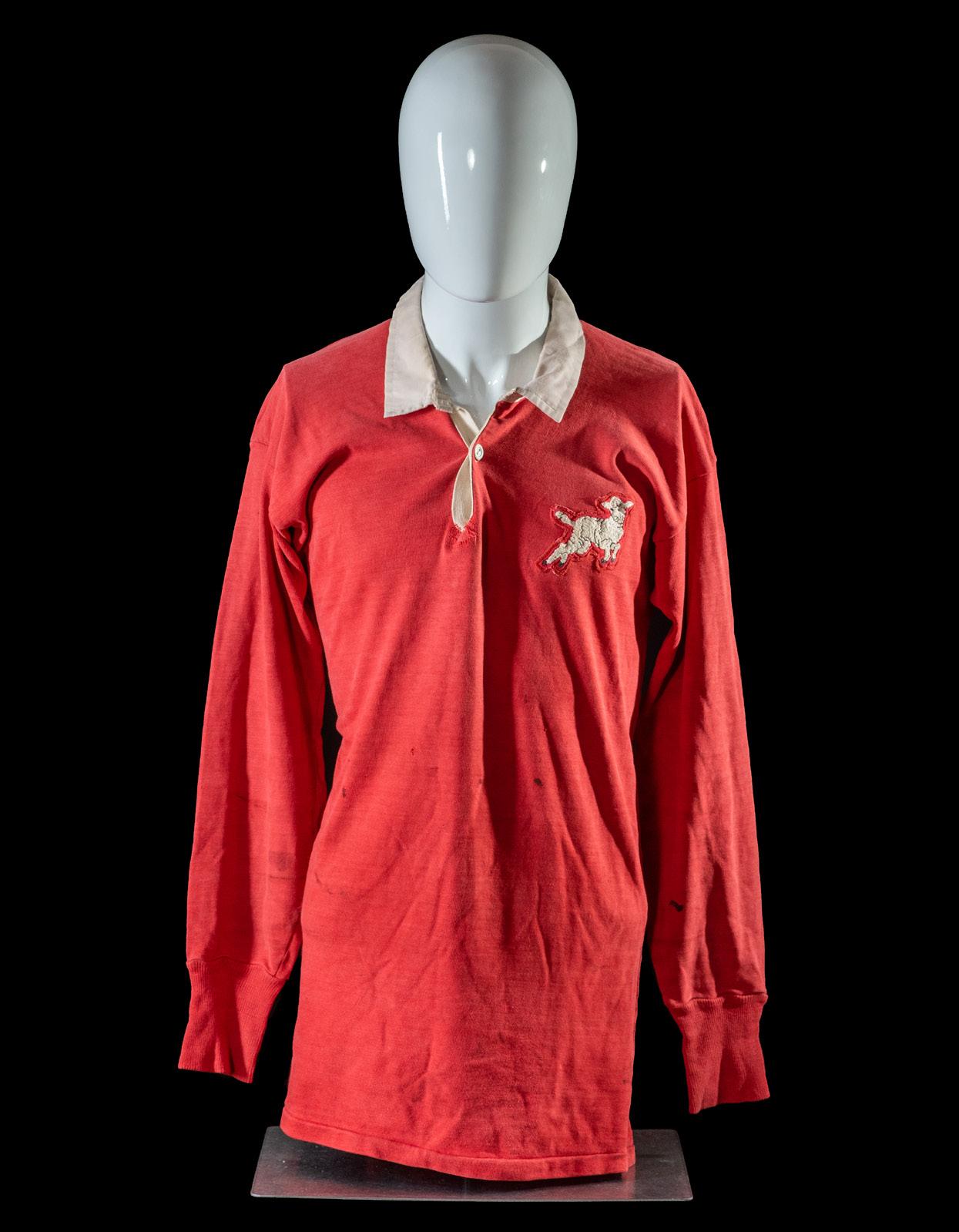
This was typical of a man who had played on with a broken arm against Eastern Transvaal in 1970, and a man who returned to the field against France in ’67, after being viciously kicked in the head as he lay on the ground.
Throughout his playing career, Meads was an almost permanent fixture in the All Blacks squad. He missed the first Test against the British and Irish Lions in 1959 but the following year he had an outstanding tour of South Africa. His try in the second Test clinched victory for the All Blacks and cemented his place for many years to come.
Meads played a major part in the tour to Britain and France in 1963 and helped to clock up series victories in 1965 and 1966 over the Springboks and the British Lions in 1967.
Colin Meads was the only player present for an All Blacks winning run of 17 matches. He captained the All Blacks eleven times including the inexperienced All Blacks team who lost the 1971 series to the British Lions - which remains New Zealand’s only defeat by the Lions. That series would mark the end of his long and illustrious 18-year rugby career.
He is still regarded as New Zealand’s finest All Black, even when players of the modern era such as Richie McCaw, who played 148 tests, surpassed Meads’ record for test appearances. After his retirement Colin Meads continued farming but also worked as an All Blacks selector and manager, mentoring generations of players to wear the famous black jersey. Former All Blacks captain and coach Brian Lochore said of Meads ‘Nobody has done more for New Zealand rugby, at any time in my view’.
Mervyn Davies, the Wales No 8 who played in the 1971 Lions series wrote of Meads, ‘No player encapsulates a nation’s attitude to sport like Colin Meads does for New Zealand.
In a land of rugby giants, he still reigns supreme and is regarded by many as the greatest ever All Black. He was the flag-bearer of New Zealand manhood’.
Meads succumbed to a long battle with cancer at the age of 81, but not before seeing his image immortalised in bronze in his hometown of Te Kuiti.
This jersey was Colin Meads’ New Zealand ‘Baa-Baas’ jersey for whom he was selected for only two matches in ‘73. It is likely that the jersey was retained for both matches therefore the only one of its kind.

The New Zealand Barbarian Rugby Club, founded in 1937, adopted the philosophies of free-flowing rugby synonymous with the original Barbarians Club in the UK.
‘What else is there to say about the great man? We became friends after many matches against each other and meeting after our playing days were over.
Colin was a colossus of a man in every sense, the type of player you would always want on your side’.
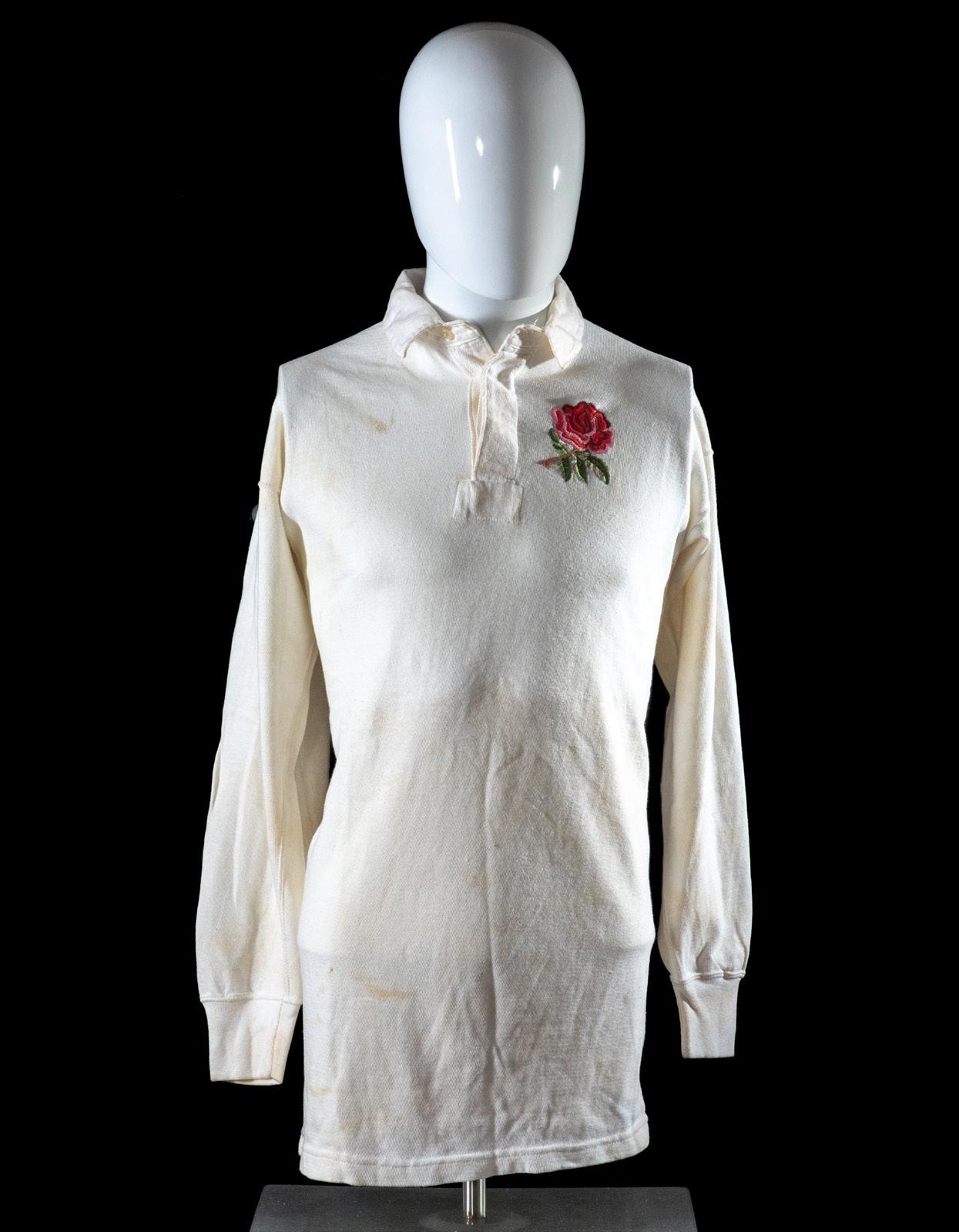
Jersey
Jan Godfrey Webster (1946-2019) made his England debut against Wales at Twickenham in 1972, one of six England players to earn their first cap that day.
He made eleven starts for England over a three-year period, and although he did not score a single international point, he was instrumental in England’s 16-10 victory over New Zealand in Auckland in September 1973 - the first away Test win by a home nation against New Zealand.
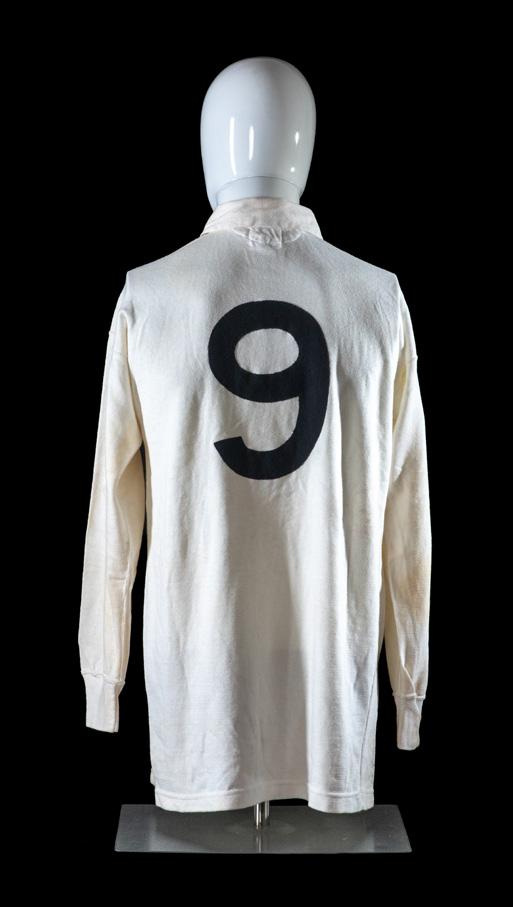
He played for England versus Wales with Sir Gareth Edwards as his opposite number four times in 1972, 1973, 1974 1975. Except for in 1974, Wales won each game.
‘I also played against Mike Lampkowski at around the same time, but I remember this jersey as Jan’s. We had some good battles’.

Jersey in original and complete condition, canvas lined shoulders of the period, complete with buttons, leaping Springbok and labels for Maxmore and Markhams, No.9 to reverse.
Provenance: the personal collection of Sir Gareth Edwards CBE & family.
At the end of 1974, he toured with the Springboks to France, playing in four tour matches, scoring one try.
Bayvel made his test debut for the Springboks in 1974 in the second test against the British Lions, a tour from which Sir Gareth Edwards brought home this jersey. Bayvel was injured before the third test but returned to the side for the drawn fourth and final test at his home ground, Ellis Park, Johannesburg.
Scrumhalf McCallum matriculated at Rondebosch Boys’ High School in Cape Town and attended the University of Cape Town. However, he first spent two years at Stellenbosch University before moving to UCT in 1967. While at Stellenbosch, he played for the University’s under–19 A team and at UCT he played for their first team. In 1968, he went to Palmer College of Chiropractic in the United States to qualify as a chiropractor. He returned to South Africa and made his provincial debut for Western Province in 1972.
He was capped by South Africa 11 times, scoring 62 points - all from the boot.
McCallum played only one test for the Springboks, against the British Lions in 1974, from which Sir Gareth Edwards brought home this jersey. That match at Newlands in Cape Town was won by the Lions 12-3. His brother, Ian was playing fullback for this match.
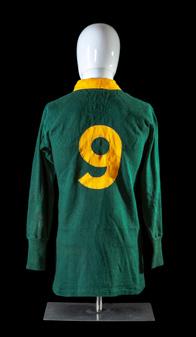
During November 1974, Bayvel toured with the Springboks to France and played in both tests as well as in three tour matches. During the 1976 New Zealand tour of South Africa, he played in all four tests against the All Blacks.
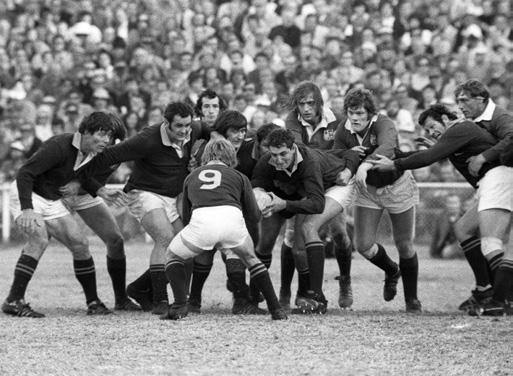
‘To win the series in the Springbok’s own backyard was a considerable achievement’.

Jersey in original and complete condition. Umbro label (two globes), Umbro print to hem, embroidered Scottish Thistle, plastic No.9 of the period.
Provenance: the personal collection of Sir Gareth Edwards CBE & family.
Douglas Waugh Morgan (1947-2020) is an important figure in Scottish rugby.
He attended Melville College, Edinburgh, where in similar vein to Sir Gareth Edwards, he excelled at many sports, captaining the cricket and hockey XIs and winning awards in swimming and athletics. Later in life he became a single handicap golfer.
In 1972, Morgan captained the combined Edinburgh/Glasgow team against the touring All Blacks. The provincial team performed admirably, losing by only 6 points to the almost invincible New Zealand team. The performance earned Morgan a debut full cap against Wales two months later in the 5 Nations Championship of ‘73. The Scottish team were the underdogs against a formidable Wales side, but Scotland managed to secure a win by one point.
Morgan was a skillful, combative scrum- half, he was capped 21 times for Scotland between 1973 and ’78 and in his final season was captain during the Five Nations’ Championship. In 1977 he toured New Zealand with the British and Irish Lions playing 13 matches including two Test appearances.

After hanging up his boots he began coaching, initially with Edinburgh, then with the national set up, contributing to the 1990 Grand Slam and Scotland reaching the 1991 World Cup semi-final. In 1993, he became Scotland coach and in 1995 led the team to a Grand Slam decider after overseeing Scotland’s famous win in Paris.
Former Scottish International and British Lion, Jim Calder, described Morgan as ‘a very inspiring figure with total self-belief who set high standards which everyone bought into. A natural captain, he prepared well for every game and was a great influence on all of us, he really was ahead of his time’.
Believed to have been swapped on March 1st, 1975 when Scotland beat Wales 12-10 at Murrayfield in the Five Nations Championship. The match was attended by a then record of 104,000 spectators. Dougie Morgan proved to be the match winner by scoring 9 of the 12 points to seal victory.

Jerseys were swapped after the game.
‘Morgan played exceptionally well that day’.

Rugby Union jersey match-worn by Gareth J R Thomas versus Newport RFC
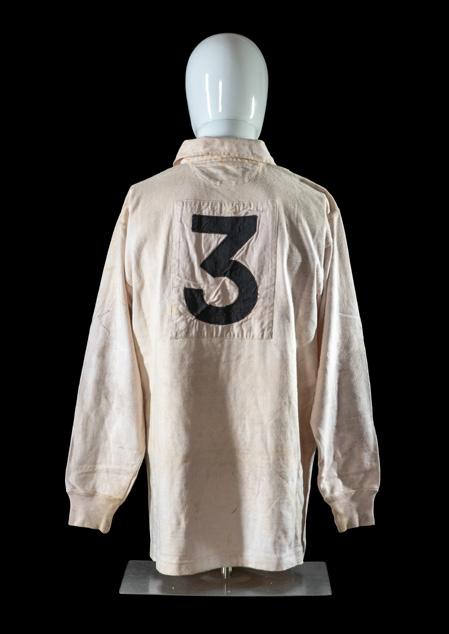
All white jersey in complete and original condition. Label for Bukta with embroidered Bukta Sportswear logo to chest, opposite embroidered black Newport badge of suspended medallion in yellow background with wings atop, embroidered ‘CENTENARY 1974-75’ below. Black No.3 in canvas white square to reverse.
Provenance: the personal collection of Sir Gareth Edwards CBE & family.
The tight-head prop for this special match was Gareth J R Thomas who acted as a late replacement for Mike Burton. Gareth was son of JBG Thomas (1917-1997), the celebrated rugby writer and chief rugby writer at the Western Mail.
G J R Thomas played 8 times for the RAF in the Inter Services Matches in the 1970s and 1980s. While a Flying Officer stationed at RAF Benson, he played tight head for the RAF v the Army in 1974, that RAF team was captained by Jeff Young. He did not play again for the RAF in an Inter Services match until 1980. He was then a Flight Lieutenant stationed at Brize Norton. In that match he played in the backrow, and he remained in that position for the rest of his RAF career.
He also served at RAF Odiham and West Drayton and he played his last Inter Services match against the Army in 1983.
Incidentally, Gareth Edwards played for RAF Cyprus against the RAF in 1972 when Jeff Young persuaded Gareth to spend a few days in Cyprus and guest for the local services team. The connections that Gareth had with the RAF and the possible JBG connection may explain why Gareth has this No 3 jersey in his collection.
The match was played on 5th April 1975 at Rodney Parade, it was a Special commemorative Centenary Match for the Newport Club.
Newport played in their traditional black and amber hoops. Phil Bennett, Bobby Windsor and Tommy David also turned out for the special match as a tribute to the illustrious history of the Newport club. The International XV won the game, 44-28.
‘It was great to reunite with players like Gareth and others for special rugby matches such as these, where the pressure is off and the occasion was more relaxed’.
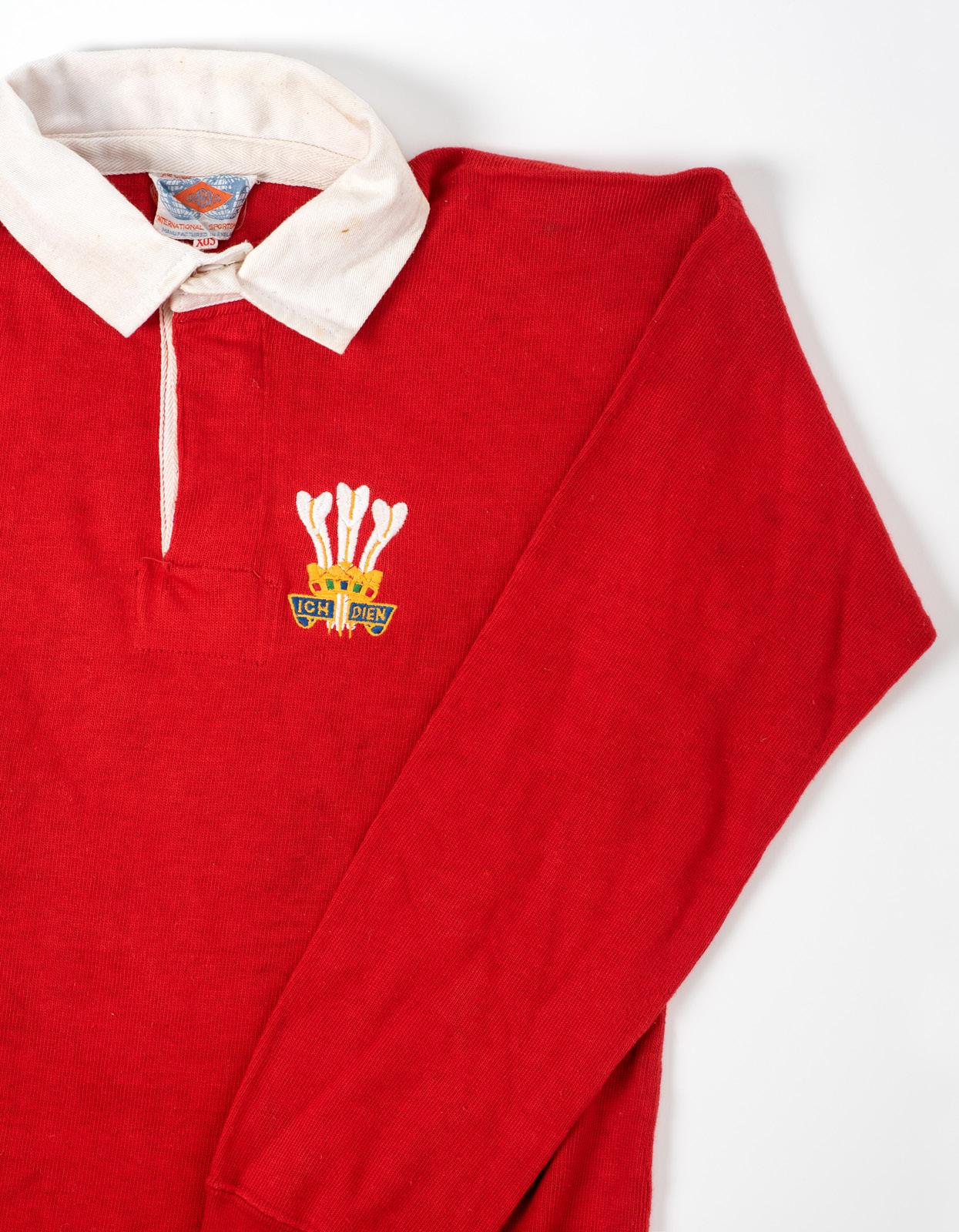
International Rugby Union jersey match-worn by Bobby Windsor
Jersey in complete and original condition. Umbro label (two globes) and Umbro print to hem, embroidered Prince of Wales feathers, complete with buttons, No.2 to reverse.
Provenance: the personal collection of Sir Gareth Edwards CBE & family.
Robert William Windsor (b.1948), known as Bobby Windsor or ‘The Duke’ was part of the famous Pontypool front row which was immortalised in the Max Boyce song.
He began his career as a fullback and outside-half but would move to the front row, winning 28 caps for Wales at that position.
He was a strong and muscular player, typical of the highly mobile and aggressive packs developed at Pontypool in the 1970s making them one of the most feared club sides of the era.
The Duke won his debut Wales cap against the Australians in 1973, in which he scored a rare try. After an impressive first season of international rugby, he was selected for the British Lions tour of South Africa in 1974.
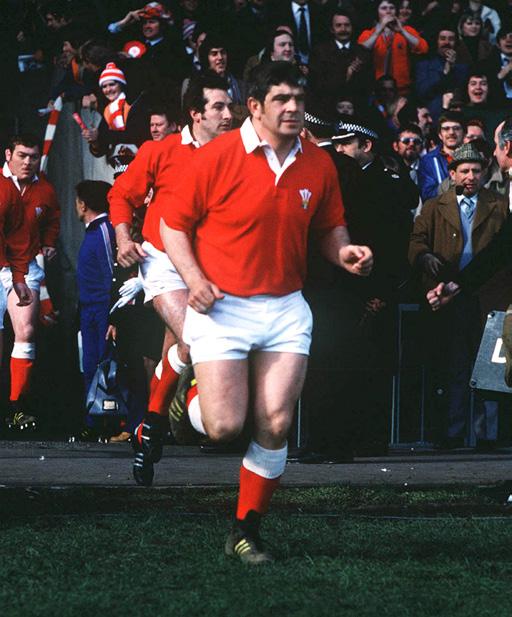
On that unbeaten tour, Windsor formed part of a formidable forward unit which dominated the Springboks and placed Windsor as one of the best hookers in the game.
With Graham Price and Charlie Faulkner ‘The Pontypool Front Row’ was an ever present in the great Welsh sides of the 1970s. The trio played together for Wales on 19 occasions in total, tasting defeat just 4 times. They won Grand Slams in ‘76 and ‘78 and the Triple Crown in ’77.
Sir Gareth Edwards and Bobby Windsor are life-long friends.
As recalled by Sir Gareth, the jersey is believed to have been worn in 1978 which was Edwards’ final season and Bobby Windsor’s penultimate.
‘Bobby was the king of one-liners, a man able to make you crack up at any time of the day or night’.
Estimate: £1500-2500
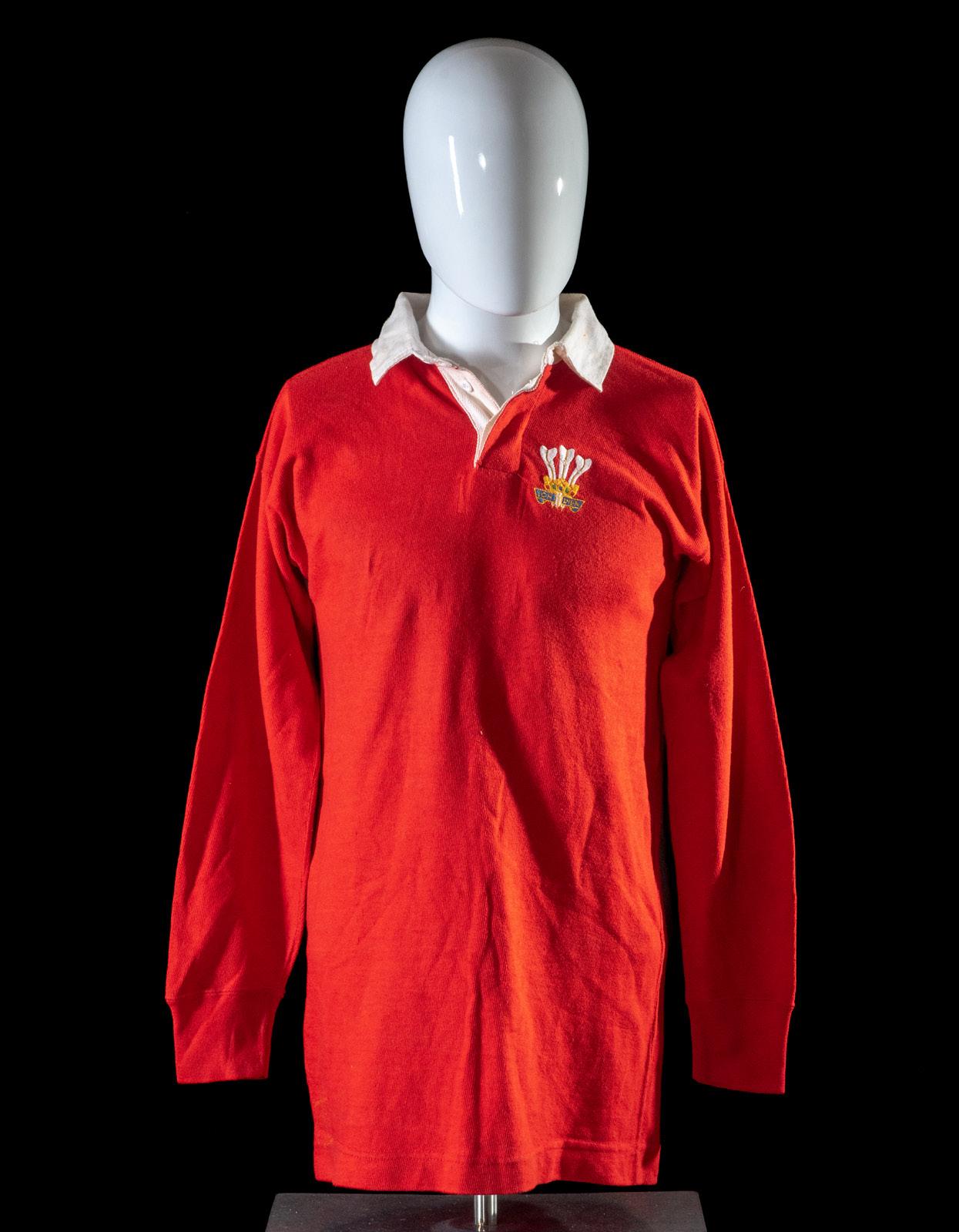

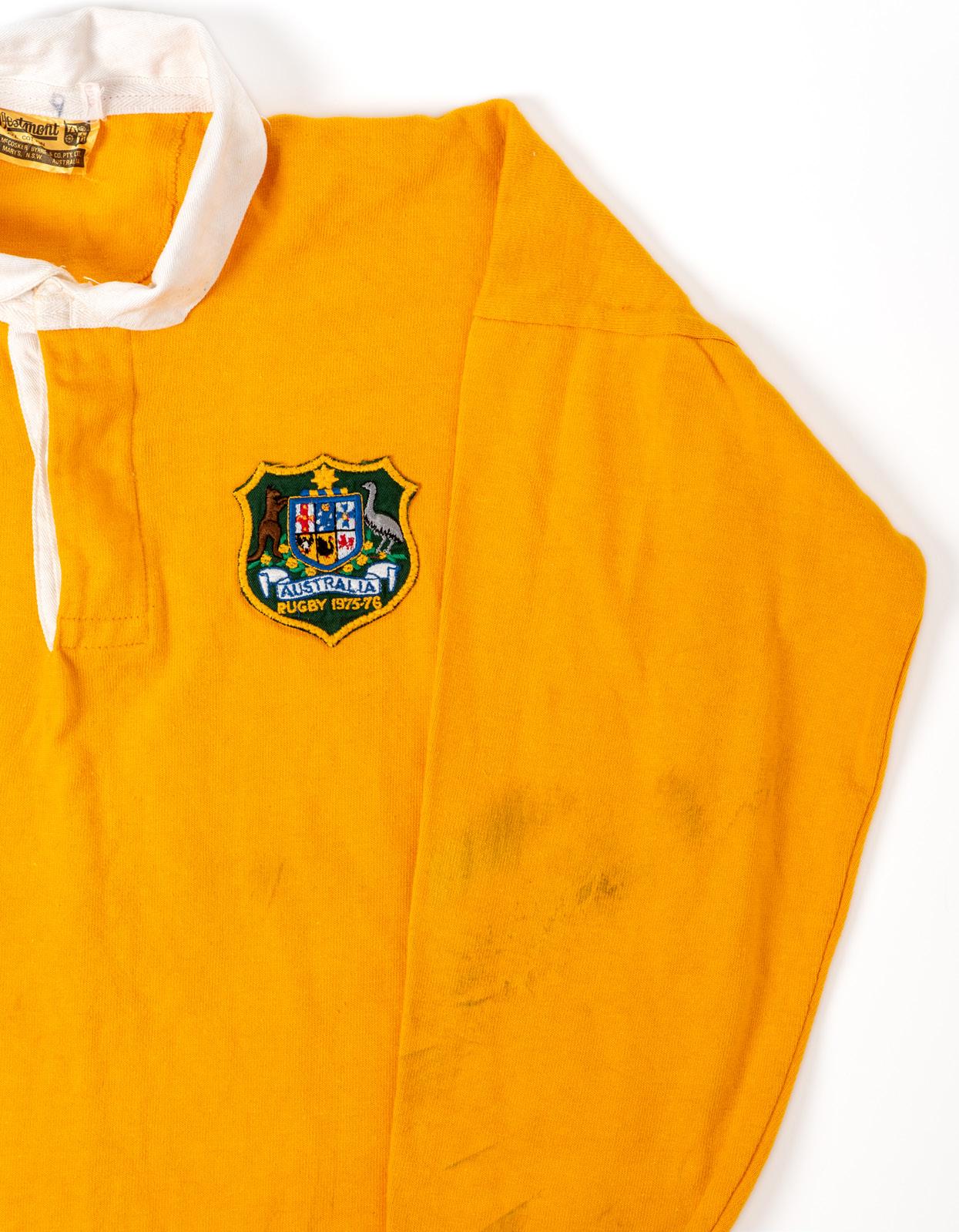
International Rugby Union jersey match-worn by John Hipwell versus Wales
Jersey in original and complete condition, embroidered with ‘Australia Rugby 1975-76’ badge, plastic No. 9 stitched to back, interior labels for Westmont No.9 faintly inscribed to interior behind label, to indicate retention for Gareth Edwards after the match.
Provenance: the personal collection of Sir Gareth Edwards CBE & family.
For further details on John Hipwell please see LOT 22
In 1975-76 the Australia rugby union team toured Britain and Ireland captained by John Hipwell.
The tourists played 26 matches between October 1975 and January 1976, ending the tour with a match on the last day of January against the USA in California. It was a disappointing tour overall for the Wallabies. They won 19 games but lost four of five international matches against the home nations, winning against Ireland only. They also lost in their penultimate match against the Barbarians in Cardiff.
The tour was especially disappointing for captain John Hipwell, the wearer of this jersey. He was one of the most experienced players in the squad having toured with the Wallabies since ‘66. He was a player of world-class reputation, an automatic selection, an intimidating scrumhalf. So, it was a massive blow, when in the 39th minute of the Welsh test, he was replaced due to recurred ligament damage.
The Australians were then beaten by Wales 28-3, a score which remains the greatest margin of victory by Wales against the Wallabies. A hat-trick of tries were scored by J J Williams, with a further try from Gareth Edwards. ‘Rothman’s Yearbook of Rugby 1975’ suggested that the loss of the Australian captain, Hipwell ‘affected the margin but not the result’. It was assumed that the knee injury would signal the end of John Hipwell’s career, but he fought back to fitness and was back in the Australian side three years later.

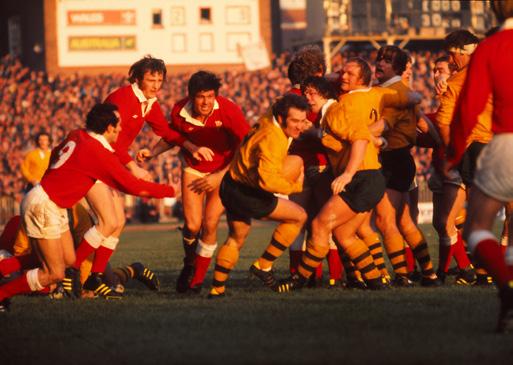
Wales!’
‘A great and memorable win for© Colorsport © Colorsport




Jersey in original and complete condition. Bears label for Sceptre. Green stem of three pink and yellow cherry blossom embroidered to black badge outline and then applied to chest, black cotton No. 19 to white square panel on reverse.
Provenance: the personal collection of Sir Gareth Edwards CBE & family.
In September 1975, Wales undertook a short early-season tour to Asia with two matches against Japan’s International side. They toured with a strong side including stars Sir Gareth Edwards, Derek Quinnell, Mervyn Davies, Phil Bennett, Gerald Davies, J J Williams, John Bevan and JPR Williams. No caps were awarded to Wales players. Both matches were won convincingly by the tourists. This squad jersey was brought back from the 1975 tour by Sir Gareth.
‘A fantastic tour and despite the final winning scores the matches were very tough. This tour set up our championship and Grand Slam win in 1976’.

Jersey in original and complete condition. Bears label for Noceto Sports, printed Puma to chest, black felt No.9 to reverse.
Provenance: the personal collection of Sir Gareth Edwards CBE & family.
Adolfo Marcelo Atchegary (b.1942) was a former scrumhalf and captain for Argentina. He played 25 Test matches between 1964 and 1976. He spent his club rugby career with the historic Buenos Aires club, Atlético San Isidro Adolfo Marcelo.

In 1976, Argentina toured Wales and England for a series of six matches culminating with a Wales XV in Cardiff Arms Park on 16th October. Etchegary was an ever-present captain for the tourists. The Pumas were then to travel back to homesoil for two tests against the All Blacks.

Wales were not awarded caps for matches against the Pumas at this stage, but the current Grand Slam winners fielded a team laden with experienced all-time greats, including JPR Williams, Gerald Davies, Phil Bennett, Derek Quinnell, captain Terry Cobner and scrumhalf Sir Gareth Edwards with whom Etchegary swapped jerseys after the game.
There was no doubting who were the favourites, the expectation was one of an inevitable comfortable victory for the star-studded men in red. However, Argentina gave Wales the greatest scare of the golden era. The Pumas put on a special performance that would stay in the memories for a long time.
At half-time the match was drawing and at injury time at the end of the game, the underdogs led 19-17. But in the dying seconds, to save Welsh blushes, Phil Bennett converted a penalty for a high tackle. Relieved Wales won the match by a single point.
The match is still hugely revered in Argentina, indeed in 2016 the Argentina Rugby Federation arranged a massive ‘gala de rugby’ to commemorate the 40th anniversary of the match. Perhaps Argentina’s performance should not have been such a shock for Welsh rugby. At fly-half the Pumas had one of the most complete rugby union footballers in Hugo Porta, who put in a typically composed performance opposite Phil Bennett. Sir Gareth chose Porta’s performance that day in his 50 great moments in the history of rugby union.
But Porta was only able to play in such a way with delivery from Etchegary as his half-back companion - wearing this jersey.
‘A close intense match, Argentina were tough and Porta was composure personified’.
Estimate: £700-1000

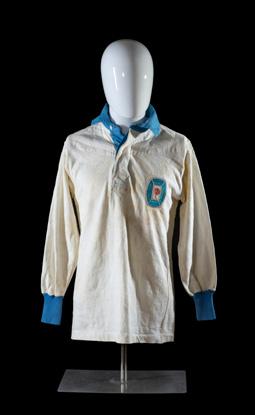


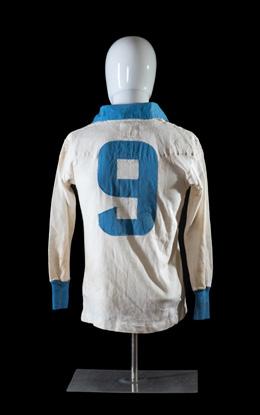
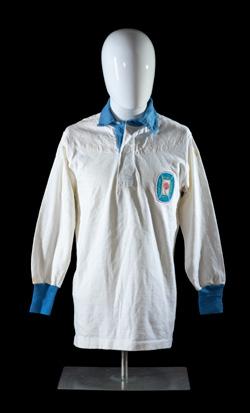
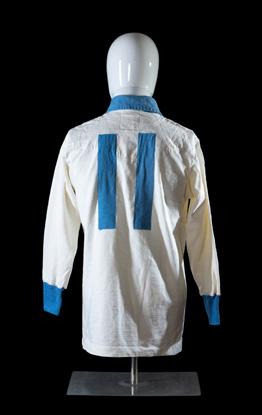
Comprising three white World XV jerseys with blue detail, bearing NTRU Loftus Verfeld 1977 commemorative crests with Barberton daisy. Numbered 11, 11 and 9. Manufacturer label for Maxmore. A zipped tracksuit top with similar crest. An all-blue match-jersey for the Noord Transvaal side with similar crest to above and bearing dark blue No.9 and another unnumbered similar. All complete and in original condition.
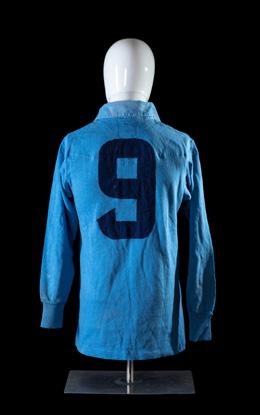
Provenance: the personal collection of Sir Gareth Edwards CBE & family.

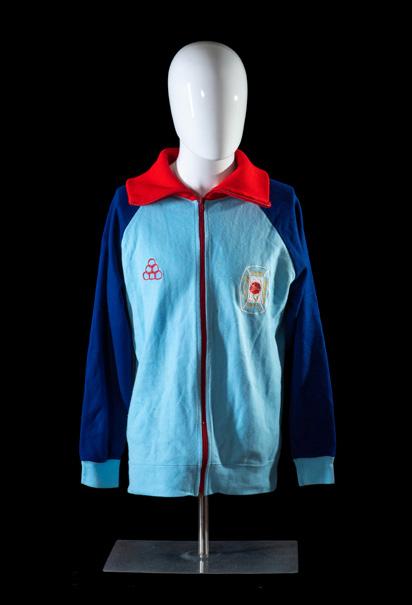
In the summer of 1977, a World XV was assembled for a short tour to South Africa. A match against a South Africa XV was arranged to commemorate the rebuilding of the new Loftus Versfeld Stadium, Pretoria, which was hailed as the most modern rugby stadium in world. The World XV were also to play a match against Noord Transvaal at Loftus Versfeld, their home ground as well as Western Transvaal.
The 1977 World XV featured, amongst others, Willie John McBride, Jean-Pierre Rives, Ian Kirkpatrick, Andy Haden, Gareth Edwards, Jean-Luc Averous and JPR Williams. Of the 1977 visit, Sir Gareth Edwards in his autobiography observed the social changes in South Africa with cautious optimism.
‘A wonderful experience to play with so many different players from around the World’.

International Rugby Union jersey match-worn by Jerome Gallion versus France in Grand Slam decider
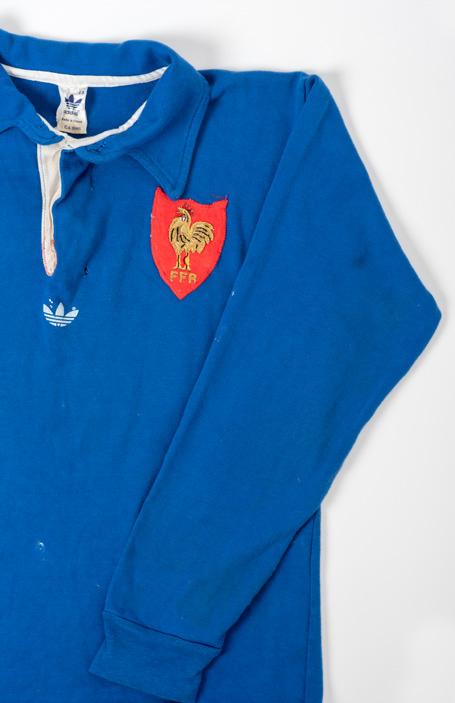
All blue jersey in original and complete condition, bears label for Adidas and Adidas logo printed to centre of chest, braided cockerel and FFR to red shield applied to chest, canvas white No.9 to reverse. Note small hole to left of crest.
Provenance: the personal collection of Sir Gareth Edwards CBE & family.
Jérôme Gallion (b.1955) was a brilliant scrumhalf who won 27 caps for France in the 1970s and 80s. Gallion made his international début for France against England in 1978, replacing the retired 1977 Grand Slam captain, Jacques Fouroux. Gallion racked up 40 points for Les Bleus with ten tries and his overall international test win rate was a very healthy 70%. Gallion also scored on his only appearance for the Barbarians, against Australia in 1984.
France played Wales in Cardiff on the 18th March in their final games of the 1978 Championship. It was the first Five Nations Championship in which two teams had three victories behind them and were to face each other in a final winner takes all Grand Slam deciding match. It was one of the most keenly awaited games of the era between the two best Northern Hemisphere teams of the 1970s.
The French arrived having beaten England 15-6 and Ireland 10-9 in Paris. In between they won 19-16 against the Scots at Murrayfield. New scrum half, Gallion was a man on form, having scored a try in each of those matches he was the leading try scorer of the Championship. They also came with bags of experience and class, including flankers Jean-Pierre Rives and Jean-Claude Skrela, centre Roland Bertranne and skipper Jean-Pierre Bastiat, making his final Test match appearance. But Wales were finely equipped as well, especially in the backline with Edwards at scrumhalf, Phil Bennett on his outside, Steve Fenwick and JPR Williams. France drew first blood in the match when Jean-Claude Skrela peeled from a driving line-out to score a try. Bernard Viviès then added a drop goal from the 10 metre line putting the French in command at 7-0.
Then it was time for Gareth Edwards and Phil Bennett. They led an onslaught that reaped them 13 critical points. Firstly, Bennett picked up a loose ball from a French scrum 10 metres out and managed to force his way over for a try which he also converted. Then his half-back partner Gareth Edwards, dropped a goal to make it 9-7.
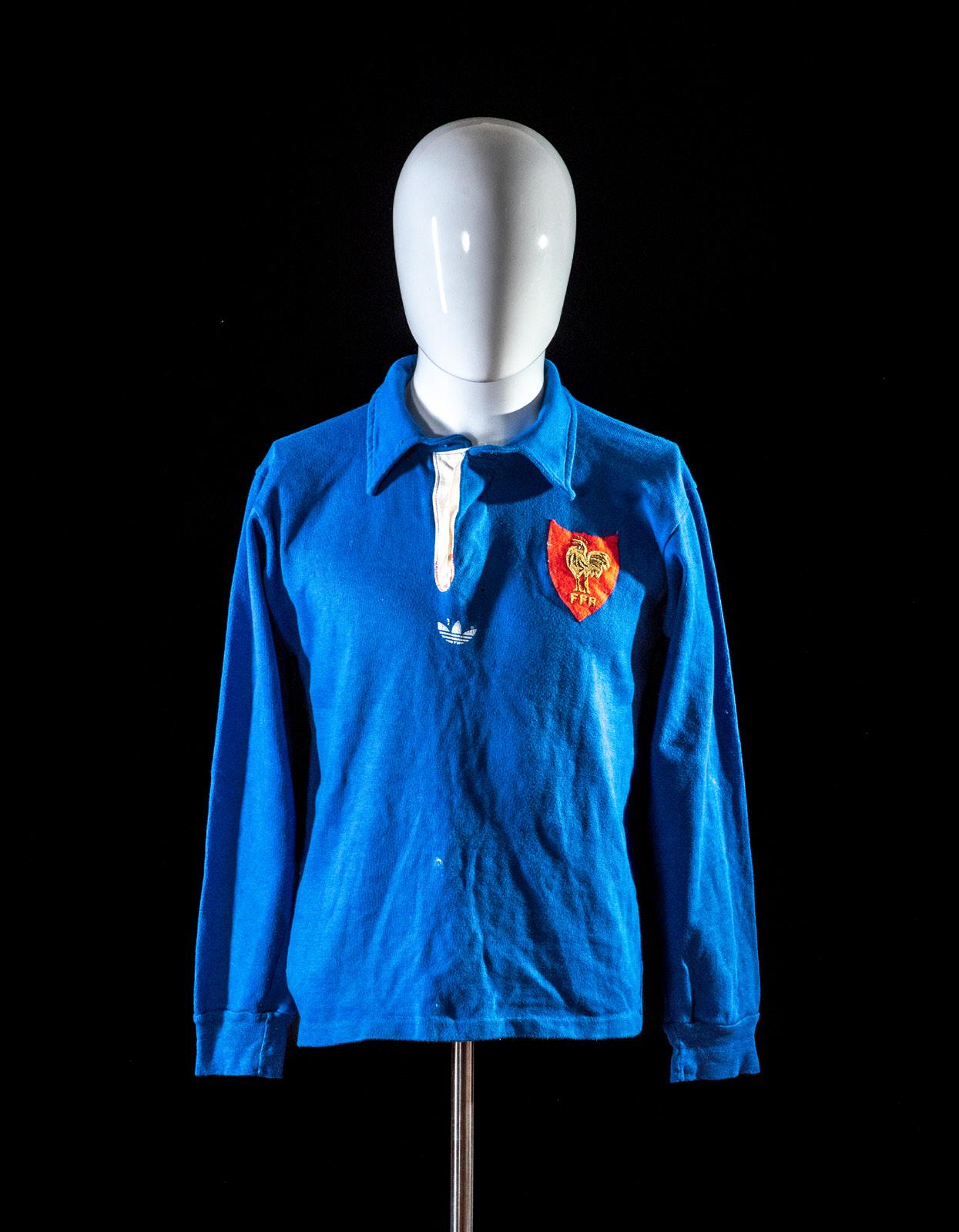
From the re-start, Wheel showed off his immense strength at a maul – he was known as ‘Ripper’ – to take the ball off a French forward and deliver to Edwards on the 10 metre line, who then kicked superbly up the right touchline and forced the French to feed a line-out 10 metres from their own try line. Having seen his second-row colleague help to set-up a great attacking position, Martin then stole the French lineout. Gravell charged into the heart of the midfield to create a ruck 10 metres out from the posts. The ball was moved back towards the right touchline, Edwards beat one man and passed out to JJ Williams who was heading out of play, but before he stepped over touch near the corner, the wing had the presence of mind to throw the ball over-arm back into play. It was a gift for Phil Bennet who touched down for the try. Now it was 13-7 to Wales with the second half to come. It continued to be a tight and tense tussle. But Steve Fenwick settled matters with the only score of the second half – a well taken Grand Slam winning drop goal.
Neither Phil Bennett nor Sir Gareth announced their retirement after the Grand Slam triumph, but both declined the chance to tour Australia in the summer.
Edwards ended his Wales career with 53 consecutive caps and a record 20 tries for his country. He also played 10 times for the Lions. Bennett took his Welsh points record up to 166 with his haul of 10 against France.
Years later Jerome Gallion remembered, ‘…playing against Gareth Edwards in his last game in 1978. The atmosphere was amazing. The noise and the singing and Cardiff Arms Park gave me goosebumps. We had a chance to win another Grand Slam, but we were beaten. I wanted to swap shirts with Gareth but I wasn’t sure he wanted to because it was his last game. I went to look for him in the changing room. He was too embarrassed to say no. His was the only shirt I kept. I hope he still has mine’.
Here is that jersey from one of the most famous matches of the 1970s.
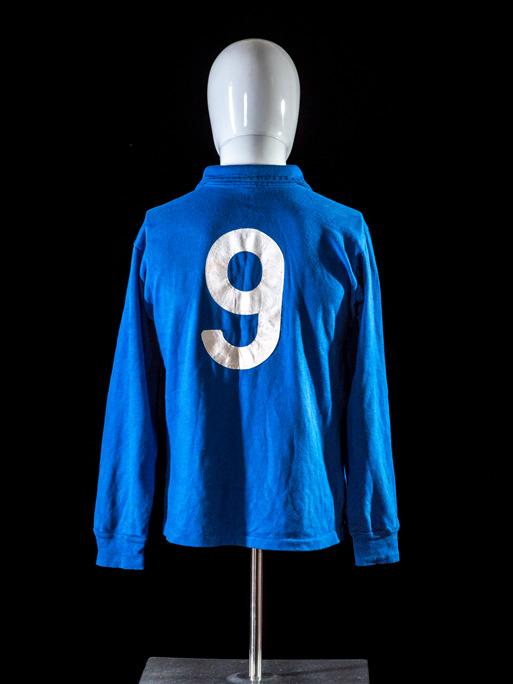
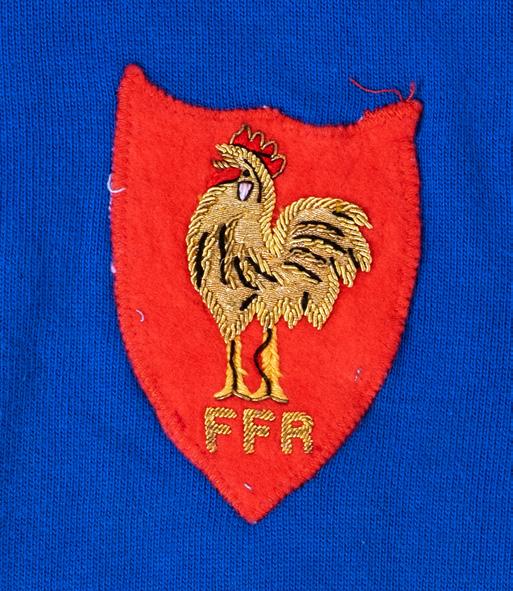
At the end (of the match), amid the jubilation of another grand slam, Jean-Pierre Rives said, in his broken English, ‘Today, Gareth, you were the old fox. You were the master. This was your day.’ And he looked at me and said, ‘Maybe next year, in Paris, it will be mine.’ And I said, ‘Yes, Jean-Pierre, it probably will be. As I spoke, I suddenly knew. I just said it to myself, ‘I don’t think there’s going to be a next year.’ And so, it proved’.
Firstly we are enormously grateful to Sir Gareth Edwards and his sons Rhys and Owen. Also to Maureen Edwards who ‘without keeping everything tidy we’d have nothing to auction’. We are proud that the family decided to consign this important collection with us here in Wales. They say ‘don’t meet your heroes’, well they were wrong in this case, as it has been a special privilege and pleasure to act on behalf of Sir Gareth and his family. Sir Gareth, Rhys and Owen Edwards have been the most supportive clients who have been extremely generous with their time. As we all know, Sir Gareth was a Superstar (physically on the BBC programme and metaphorically), but I have learnt that being a superstar can come with humility, kindness, and generosity. I would also like to thank Peter Owens at the WRU, an esteemed professor when it comes to rugby history and rugby jerseys. Thanks also to Rob Cole at Westgate Sports Agency and David Norrie at Colorsport, to Mary Wycherley for her patient and thorough photography and to Mark Edwards of Polar 10 for his enthusiasm and creativity.
I dedicate this prospectus to my Dad who shared the excitement of being entrusted with this collection but who sadly did not live to see the auction. Dad may well have been at the Barbarians v New Zealand match - if only I wasn’t about to make my first appearance! I am so grateful to Dad for showing me the ropes and for his unwavering support over the years.

